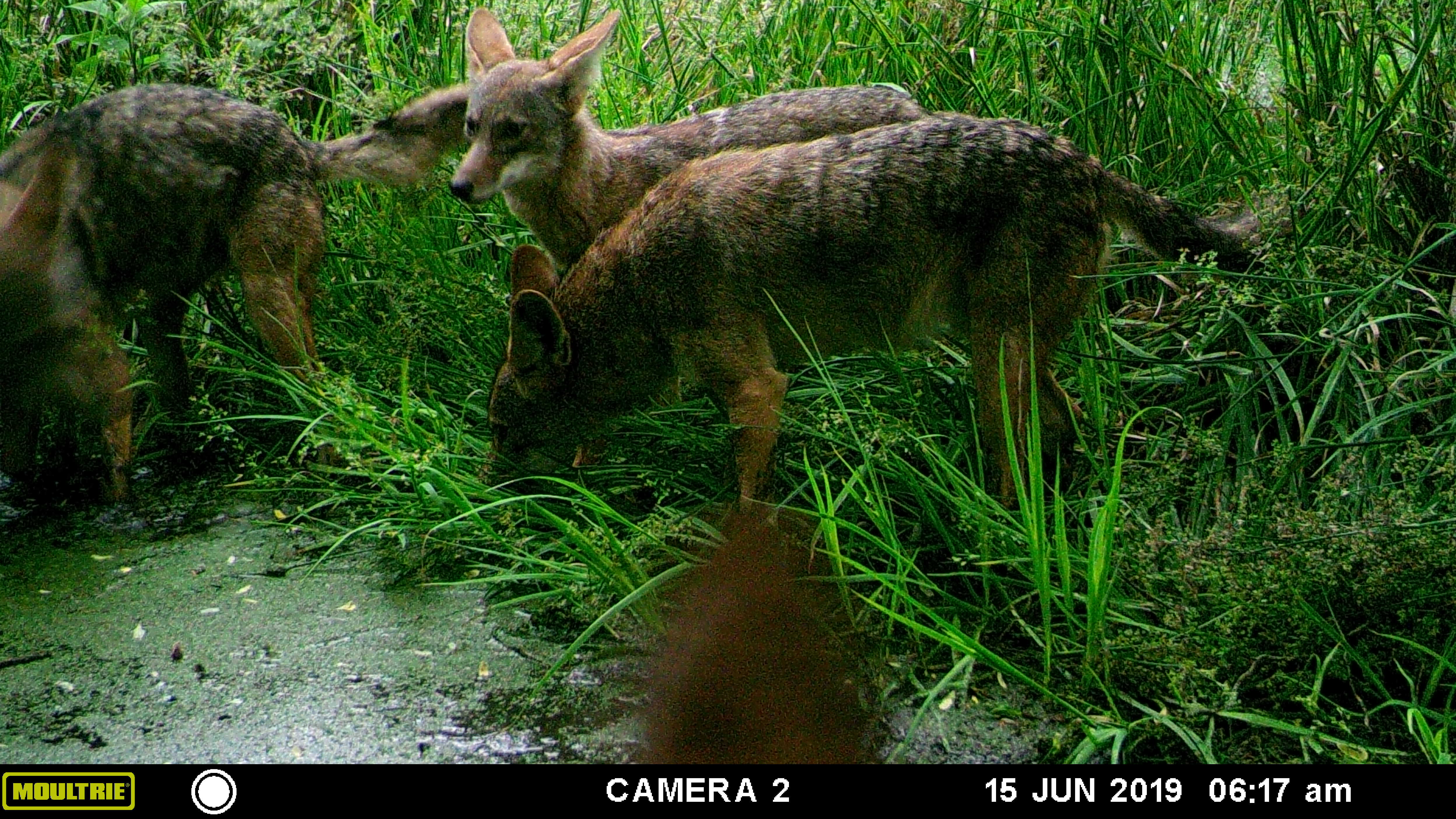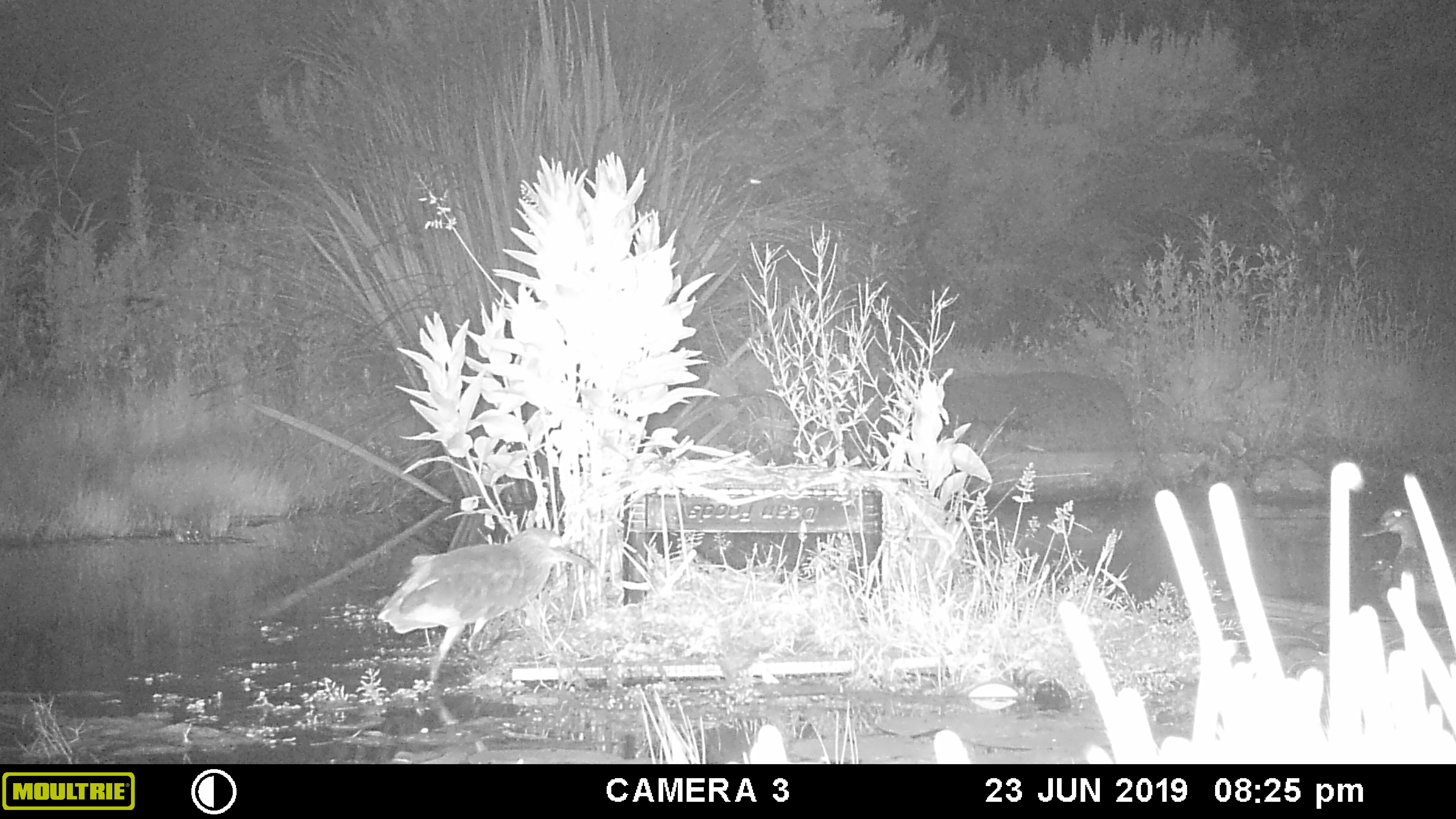-
We Host the Smallest Bats in the United States
 Our seven year-old chemical-free food forest habitat became the release site for an adorable pair. Two young rescued brothers that had been cared for by Cindy, a Project Wildlife/SD Humane Society bat team volunteer needed a safe, comfortable, food-rich home.
Our seven year-old chemical-free food forest habitat became the release site for an adorable pair. Two young rescued brothers that had been cared for by Cindy, a Project Wildlife/SD Humane Society bat team volunteer needed a safe, comfortable, food-rich home.  These two were Canyon bats, the western pipistrelle (Parastrellus hesperus) which are members of the smallest bat species in the United States. Their wingspan is at longest 8″, and their furry brown bodies are only about 6″ long.
These two were Canyon bats, the western pipistrelle (Parastrellus hesperus) which are members of the smallest bat species in the United States. Their wingspan is at longest 8″, and their furry brown bodies are only about 6″ long.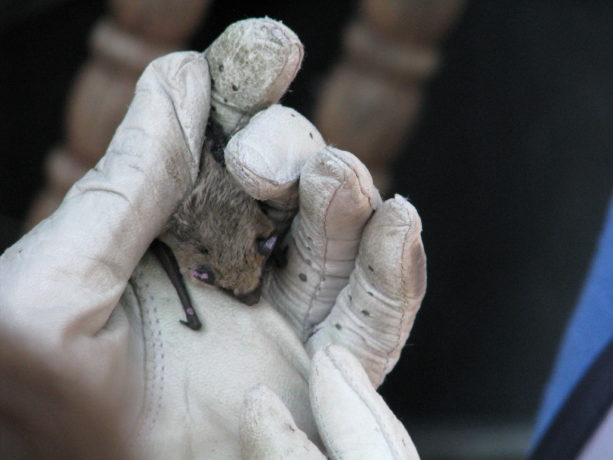 These insectivores are crepuscular, meaning they feed around sunset and dawn rather than during the night. They are also not colonial bats, but are often on their own eating the mosquitoes, beetles, small moths and flies around your home. Females will usually bear twins, rare for a bat, in June, and live either by themselves or in a small maternity colony. Here in October, these two little bats were from an early summer birth and were more than ready to get out of the rescue flight cage and be off on their own.
These insectivores are crepuscular, meaning they feed around sunset and dawn rather than during the night. They are also not colonial bats, but are often on their own eating the mosquitoes, beetles, small moths and flies around your home. Females will usually bear twins, rare for a bat, in June, and live either by themselves or in a small maternity colony. Here in October, these two little bats were from an early summer birth and were more than ready to get out of the rescue flight cage and be off on their own. 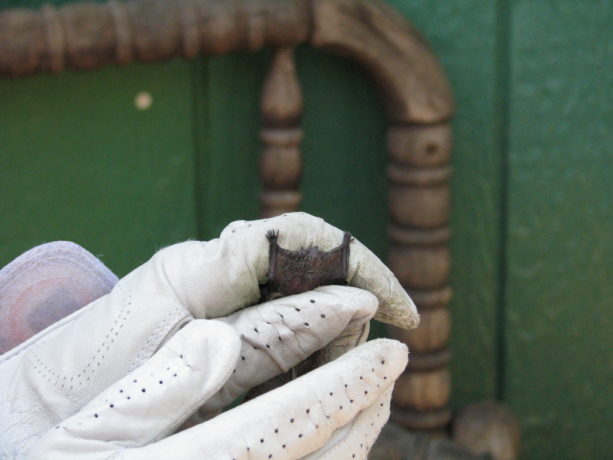
They were carefully allowed to crawl up into a bat house that had been hanging empty for five years. It was facing east so as to warm in the morning, and protected from the hot afternoon sun. The inside of the bat house had rough textured wood so the very tiny little feet had texture on which to grab. We made sure than there were no containers such as buckets or nursery cans facing up; many young bats fall in and can’t get out.

It was close to our chemical-free unlined pond for easy bug access at dining times, and which has enough open space for swooping across to get a mouthful of water. They may return to the bat house, or they may fly off to find a rocky nook or tree crevice that they like better, but we sure love them being released in our garden.
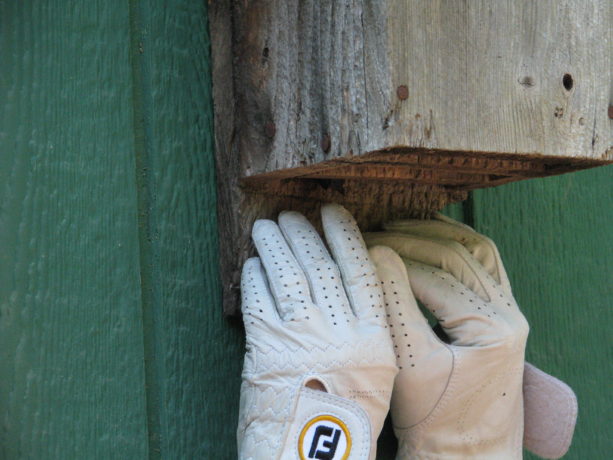
In permaculture, all the animals: bats, lizards, frogs, birds etc. are vital parts of the integrated pest management system as stated by pest control st paul, and also contribute to soil fertility with their droppings, sheds, feathers, leftover meals and bodies. When you spray for insects you kill the food supply for these animals which has effects throughout the food chain. Gardens should be alive with native wild animals and insects, and not reduced to only a scavenging ground for invasive rats and domestic cats.
At dusk or early in the morning keep an eye out for bat species in your yard. They are working to keep the insect population in control.
Project Wildlife | San Diego Humane Society
San Diego County is one of the most biologically diverse areas in the United States with the greatest number of endangered species. People from all over the county bring wildlife patients to Project Wildlife for care and we are proud to be a resource that our neighbors can depend on in order to coexist peacefully with wild animals.
- Animals, Bees, Gardening adventures, Grains, Health, Heirloom Plants, Herbs, Other Insects, Permaculture and Edible Forest Gardening Adventures, Planting, Seeds
Growing and Eating Seeds
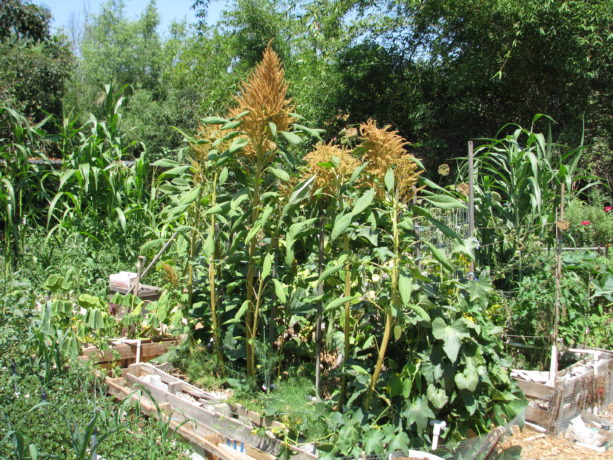 We eat seeds everyday. Grains, nuts, beans and, well, seeds, are all seeds. A seed is an embryonic plant covered with a seed coat. A grain is a dried fruit. In this blogpost I’m going to concentrate on true seeds.
We eat seeds everyday. Grains, nuts, beans and, well, seeds, are all seeds. A seed is an embryonic plant covered with a seed coat. A grain is a dried fruit. In this blogpost I’m going to concentrate on true seeds.Grains are usually seeds from grasses, although there are common exceptions to that rule such as the amaranth below. Seeds contain the magic that makes a plant out of a speck; a towering oak from an acorn. Seeds are highly nutritious for humans as well, but often are just used as a flavoring (think of an ‘everything’ bagel). Many have been used medically for relieving everything from eczema to mental issues. Some seeds such as grains are difficult to prepare for eating on a small scale, such as rice. Separating seeds from chaff takes a lot of steps that may not be practical for the handful of food at the end of the process. However there are many seeds that we commonly eat that are easily grown among the veggies, or even in a flower bed. Here are some that we grow at Finch Frolic Garden Permaculture:
Let’s start with one of my favorite flavors, the sesame seed.
 Sesame (Sesamum indicum) seeds grow on small upright plants about 2 – 3′ high that have lovely tubular flowers.
Sesame (Sesamum indicum) seeds grow on small upright plants about 2 – 3′ high that have lovely tubular flowers. 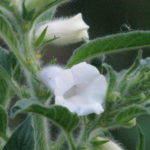 Bees love to crawl into them. Its a pretty plant and flower, so could easily be incorporated into an ornamental area. There are both black and white sesame seed plants; the white seed is really brownish as it has a seed coat. Sesame is also called benne seed. Once harvested sesame seeds should be stored in a dark cool place or refrigerated. The seeds can be used raw, or better still lightly toasted in a dry pan before sprinkling over your food. So very yum. Tip: sesame pods become tight as they dry and then split with force, throwing the seeds away from the plant. If you want to harvest any then watch the pods as they dry on the plant and then cut and hang in a paper bag to catch the seeds as they fly, or break open with your hands.
Bees love to crawl into them. Its a pretty plant and flower, so could easily be incorporated into an ornamental area. There are both black and white sesame seed plants; the white seed is really brownish as it has a seed coat. Sesame is also called benne seed. Once harvested sesame seeds should be stored in a dark cool place or refrigerated. The seeds can be used raw, or better still lightly toasted in a dry pan before sprinkling over your food. So very yum. Tip: sesame pods become tight as they dry and then split with force, throwing the seeds away from the plant. If you want to harvest any then watch the pods as they dry on the plant and then cut and hang in a paper bag to catch the seeds as they fly, or break open with your hands.Amaranth:
Amaranth (Amaranthus spp.) is a very tasty, easily grown seed that is considered a grain. It was a major food of the Aztecs, and almost completely destroyed by the Spanish after their conquest of that civilization. Amaranth was too sneaky though and survived. It is easily digestible, high in protein and full of other nutrition. It has wild as well as ornamental varieties, but all are edible (be sure what you are eating!) Love-lies-bleeding is the dramatic name of the long red tasseled kind.
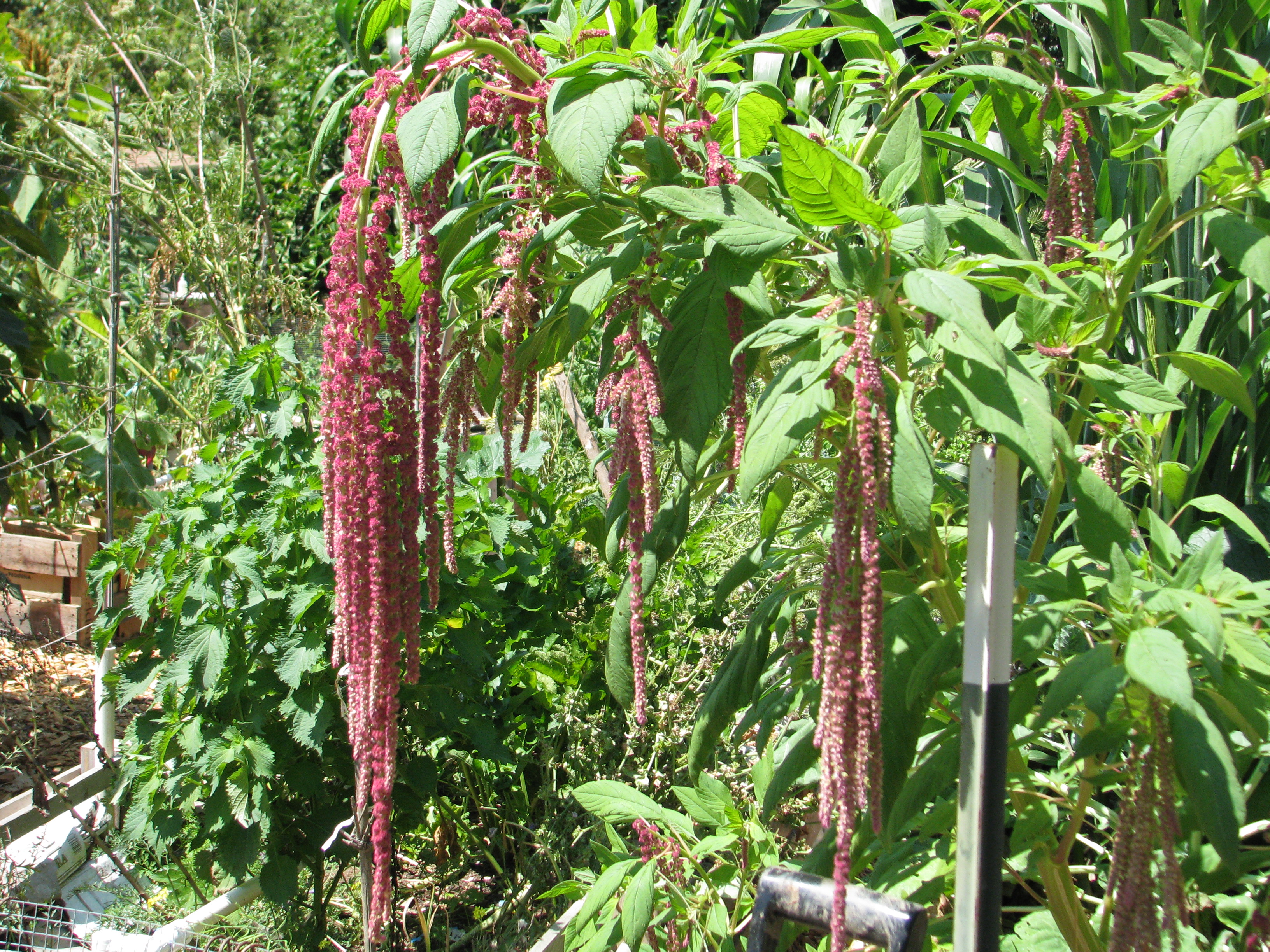

All are great for birds as well as humans.
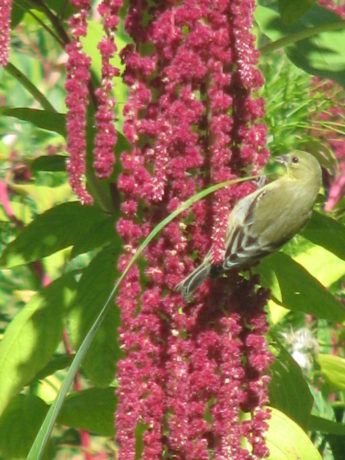
Pigweed and lambsquarter are its weedy relatives. All of them have edible leaves, although some varieties are more tasty than others. Older leaves are better cooked. The tall varieties can grow 8′ tall or so, may need staking, and make good shade plants for others that need sun protection. When you start to see birds on the flowers then the seed should be ready. Another way to check is to gently rub the flowers between your fingers and see if seeds come off as well as the petals. If so, then over a clean, dry bucket rub the cut flowers between your fingers. Winnow the chaff away over a mesh screen or in the wind, or by gently blowing it away from the seed. Now you need to completely dry the seed in the sun, and then store in a dry, dark cool place. Use within six months for best results.
Poppy seeds:
 No, not the opium kind, the lemon-poppy seed cake kind, although both are varieties of Papaver somniferum. Look for seeds for Breadseed Poppy varieties. This is another beautiful ornamental with striking seed pods that can be dried and used in flower arrangements. Poppies enjoy poor, disturbed soil. The seeds are tiny so need to be exposed to daylight to germinate. The flowers are beautiful; frail and feminine. The seed pods are rounded and have tiny holes at the top where the seeds come out of, so be careful when you are working around the drying pods or you’ll scatter seeds. Or just let some drop and they will come up next year.
No, not the opium kind, the lemon-poppy seed cake kind, although both are varieties of Papaver somniferum. Look for seeds for Breadseed Poppy varieties. This is another beautiful ornamental with striking seed pods that can be dried and used in flower arrangements. Poppies enjoy poor, disturbed soil. The seeds are tiny so need to be exposed to daylight to germinate. The flowers are beautiful; frail and feminine. The seed pods are rounded and have tiny holes at the top where the seeds come out of, so be careful when you are working around the drying pods or you’ll scatter seeds. Or just let some drop and they will come up next year.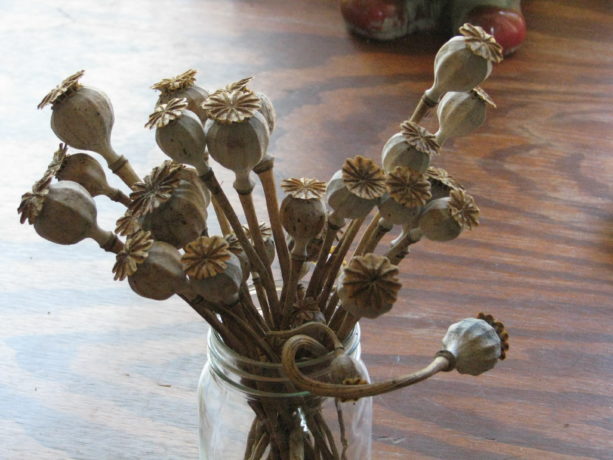
 Allow the pods to dry on the stem and then carefully cut. Shake the seeds out into a jar and store in a cool, dark place. Use raw or lightly toasted. Be sure not to eat them before taking a drug test, or you’ll test positive.
Allow the pods to dry on the stem and then carefully cut. Shake the seeds out into a jar and store in a cool, dark place. Use raw or lightly toasted. Be sure not to eat them before taking a drug test, or you’ll test positive.Basil seeds:
 Basil seeds aren’t well known for their culinary use in the US, but they are nutritious and useful. The seeds of the sweet basil plant (Ocimum basilicum) not Holy Basil (Ocimum tenuiflorum), when soaked make the water gelatinous, as chia seeds do, so are used to thicken drinks and foods. You don’t have to soak basil seeds to use them though. The flowers are delightfully edible as well. Use them for additional flavor and nutrition by tossing them raw into salads, salad dressing, breads, or just about anything. Letting some of the basil plant go to seed (while pinching other stems to keep it leafing) will attract small native pollinators to your garden. When the flowers dry, the seeds are ready to be shaken off into a clean, dry bucket or bag.
Basil seeds aren’t well known for their culinary use in the US, but they are nutritious and useful. The seeds of the sweet basil plant (Ocimum basilicum) not Holy Basil (Ocimum tenuiflorum), when soaked make the water gelatinous, as chia seeds do, so are used to thicken drinks and foods. You don’t have to soak basil seeds to use them though. The flowers are delightfully edible as well. Use them for additional flavor and nutrition by tossing them raw into salads, salad dressing, breads, or just about anything. Letting some of the basil plant go to seed (while pinching other stems to keep it leafing) will attract small native pollinators to your garden. When the flowers dry, the seeds are ready to be shaken off into a clean, dry bucket or bag. Coriander:
You probably know cilantro or Chinese parsley as the love-it-or-hate-it herb found in salsas and many Mexican or East Indian dishes. Cilantro (Coriandrum sativum) seed is called coriander. Coriander seed is usually used ground and used in curry mixtures, soups and meat dishes. It is an historical herb, being used in ancient India, China and Egypt. It has a kind of lemony taste that is unique.
Celery seeds:
Celery (Apium graveolens) seeds are marvelous savory additions to soups, particulary tomato. I grind it up in a mortar and throw it in soups and stews to round out the flavor. We grew celery one year -although I have no photos of it – and because of the warm weather the celery stalk flavor was quite strong. However the seeds were delightful. Celery is a cool-season plant and the stalks should be covered to keep pale green and mild flavored. Or just let them grow for the seed. There is a wild variety that grows in marshlands, but please be very careful if you harvest from it because it looks similar to the very poisonous water hemlock (Cicuta).
Fennel:
If you’ve sipped ouzo, aguardiente or anisette, you’ve tasted the seeds of the fennel plant. Fennel (Foeniculum vulgare) is the brother of anise, and both have escaped gardens to be a troublesome weed. Fennel bulbs are absolutely amazing lightly steamed, and then baked in vegan butter and topped with vegan Parmesan. The leaves are fantastic stirred into eggs or salads, and the seeds are incredible flavorings for baked goods, candies and obviously alcohols. Miranda candied fennel seeds for me. They have been used to try and mask cigarette or alcohol breath, but really… who is kidding who? They do make a great breath freshener chewed. The plants are frondy, tall and have pretty umbels of flowers that native insects love.
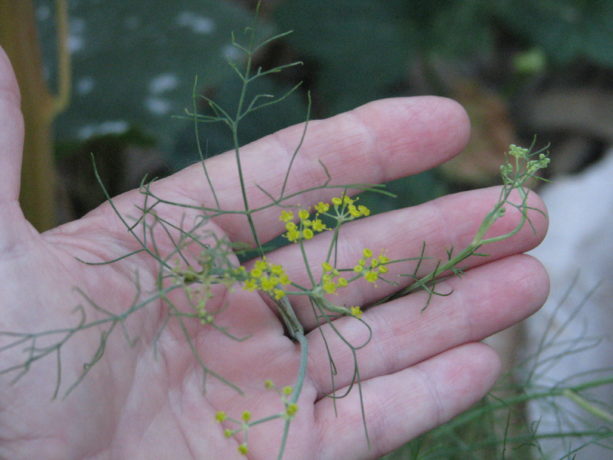 Grow some for the bulbs (protect them from gophers!) and let others go to seed. Cut and hang upside down to collect the seed in a bag or else you’ll have fennel everywhere. And that may not be a bad thing.
Grow some for the bulbs (protect them from gophers!) and let others go to seed. Cut and hang upside down to collect the seed in a bag or else you’ll have fennel everywhere. And that may not be a bad thing.Sunflower
I don’t know anyone who isn’t familiar with sunflower seeds; certainly the shells were routinely spit out all over campus as a cool snack when I was in college and probably still are. At least they are biodegradable. Sunflowers (Helianthus annuus) are one of the few edible seeds native to North America, and they are protected in an attractive hull. Some varieties are small, multi stemmed and ornamental, and others are grown for their fabulously large seed heads. Birds love eating the green leaves as part of their healthy diet, so grow extra. The seed heads should be left to dry on the stalk, and then cut and shaken to de-seed. Good pollination is important to produce seeds with good ‘meat’ inside.
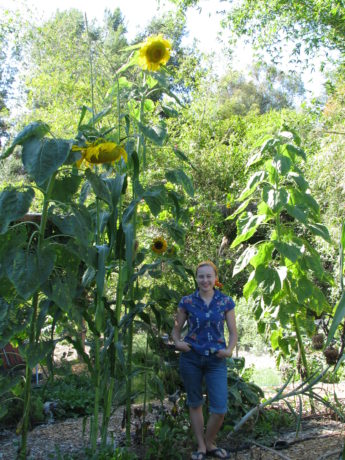
Eat them raw or toasted; they are full of good things for your body. (Miranda is 5’1″ in the photo, not tiny. I like that one of the heads seems to be checking her out.)
Dill
Dill (Anethum graveolens) is another double happiness plant. The leaves are tremendous used fresh or dried, and the seeds are fantastic as well. We use the whole seed heads in our dill pickle recipe. It goes well with fish, or in our case vegan fish. Grind them or use them whole, but definitely stir them into sauces, soups, dressings, dips, etc. Dill, like fennel, will reseed, but that isn’t a bad thing. They look pretty much like the fennel plant above.
Caraway:
We’ve grown caraway (Carum carvi) in the past, but I have no picture for you. Just refer to the photo above of the fennel and it will be close, as they are in the carrot family. You’ll find caraway in rye breads, liquors and cheeses, and in some areas the young leaves and roots are also eaten. They are dried and harvested just like the fennel and dill.
There are other seeds that we haven’t grown. We’ve tried to grow cumin and annatto seeds, but have failed to make them germinate; there is always next year. Some seeds are so small, such as chia, that you’d have to grow a lot of plants to harvest just a little seed. Seeds are such a vital nutritional and flavorful part of our diets, and so fun to grow that everyone should sprinkle edible seed-bearing plant seeds throughout their garden. As seeds dry and keep fresher longer than dried leaves (such as basil or dill), that fresh taste of the garden can last through until next year’s harvest time again.
- Gardening adventures, Permaculture and Edible Forest Gardening Adventures, Recipes, Seeds, Vegan, Vegetables, Vegetarian
Glorious Beet Greens
 Did you know that beet greens are gloriously edible? That they are tender, not bitter, mild, easily cooked and full of nutrition? As I was never a beet lover, I didn’t know that either. I’ve loved Swiss chard with its slight bitterness, intense flavor,
Did you know that beet greens are gloriously edible? That they are tender, not bitter, mild, easily cooked and full of nutrition? As I was never a beet lover, I didn’t know that either. I’ve loved Swiss chard with its slight bitterness, intense flavor, 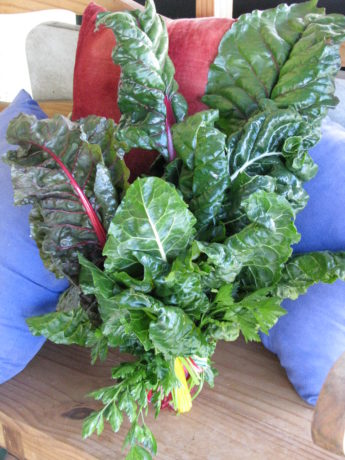 and huge leaves
and huge leaves  but I wouldn’t go near a beet until a few years ago. I would make vegetarian borscht (Russian beet soup) for my father but never taste it and hope that it came out well. Then I was gifted with a jar of pickled beets and I had to try them to not insult the giver… and I liked them. Strangely, pickled beets go really well with curry. So Miranda and I grew beets, and let some go to seed.
but I wouldn’t go near a beet until a few years ago. I would make vegetarian borscht (Russian beet soup) for my father but never taste it and hope that it came out well. Then I was gifted with a jar of pickled beets and I had to try them to not insult the giver… and I liked them. Strangely, pickled beets go really well with curry. So Miranda and I grew beets, and let some go to seed. This year we had hundreds coming up in the garden.
This year we had hundreds coming up in the garden. Good thing that we found out about the greens. Now I’d grow beets just for their greens and pull some early for the root. Just keep cutting the greens and the beet root will continue to produce leaves, although the root will grow large and too tough to eat. Then allow it to go to seed.
Good thing that we found out about the greens. Now I’d grow beets just for their greens and pull some early for the root. Just keep cutting the greens and the beet root will continue to produce leaves, although the root will grow large and too tough to eat. Then allow it to go to seed. We planted many different kinds of beets, and although the roots tasted a little different the tops all tasted just as good. We also planted sugar beets, and they were so very sweet and yet earthy that I really didn’t care for them as a vegetable. My favorite beet root is chioggia which as lovely red circles when sliced. We purchased all of our beet seeds from Baker Creek Organics.
Beets have deep tap roots, therefore they are excellent ‘mining’ plants in a plant guild. They bring nutrients up from deep in the soil, and what leaves you don’t eat can be put back on or in the ground to create topsoil.
Beet greens can be torn up and put into a salad raw or used in place of lettuce on a sandwich. To cook beet greens, wash and tap off excess water, tear up and put into a medium hot pan that has a little olive oil coating the bottom. Stir until wilted. You can eat them from this point as they are not stringy. If the leaves are older I’ll put a little more water in if needed, turn down the heat, cover the pan and let the leaves steam for a few minutes. You don’t need salt or salty broth as the leaves have a strong enough taste. Eat them with vegan butter as a side dish, stir them into omelettes or frittatas, or use them any way you would spinach.
Freezing beet greens is easy. Wash them, shake off excess water, and put into freezer bags. They aren’t mushy black when thawed and cooked.
Grow your extra organic beets and leave some of them just for harvesting greens. You’ll want to fill your yard and your plate with them!
- Animals, Bees, Birding, Gardening adventures, Natives, Other Insects, Permaculture and Edible Forest Gardening Adventures, Predators, Reptiles and Amphibians, Varmints
Insects: Pest or Partner?

Ladybug on ragweed, chowing down on the aphids. Finch Frolic Garden has been insecticide-free since it was first planted. It is a wildlife habitat as well as a food forest, and there are no chemicals at all used. Instead we rely on that habitat to create an integrated pest management system you can click to see how it works.

Western fence lizards are in and out of all of our veggie beds. We use no fertilizers other than compost, so they are safe. The abundant frogs and lizards balance out most of the insect populations, and the birds, particularly bush tits and the other smaller gleaners, do their share.
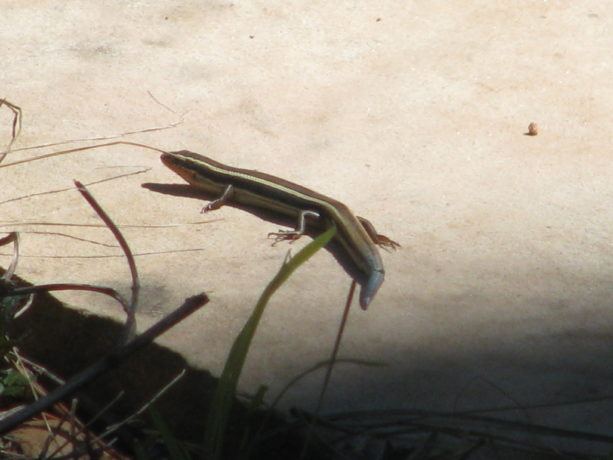
A surprise visit from a skink! Welcome, little bug eater! It may seem counter-intuitive to invite in and create habitat for insects when insects do the most damage.
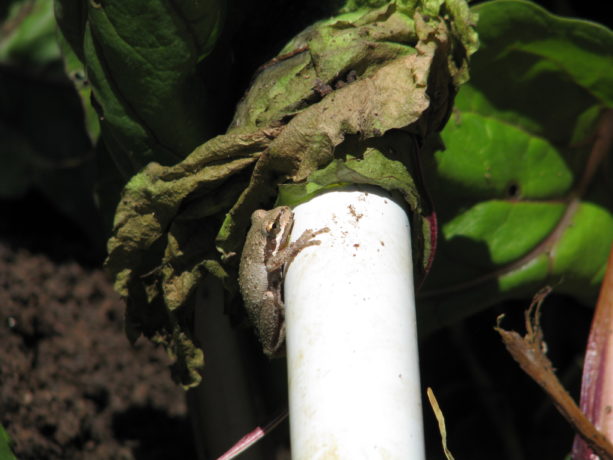
A Baja California Treefrog, a.k.a. Pacific Chorus Frog (Pseudacris hypochondriaca hypochondriaca), clinging to the PVC pipe in the beet bed. He’s keeping the bugs in check while being cute. But like humans, bugs are bug’s own worst enemy. Bring in the native insects!
Observation plays an enormous role in successful pest management says this Bed Bug Specialist Los Angeles California; what better excuse for sitting in your garden looking at flowers?
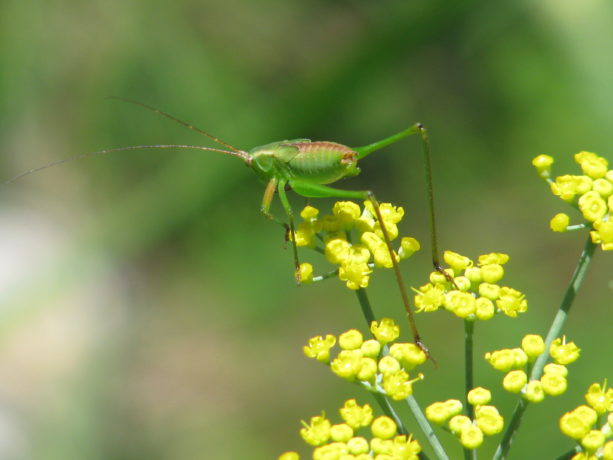
Mexican Bush Katydid (Scudderia mexicana) on fennel. For that is where you’ll see most of the beneficials.
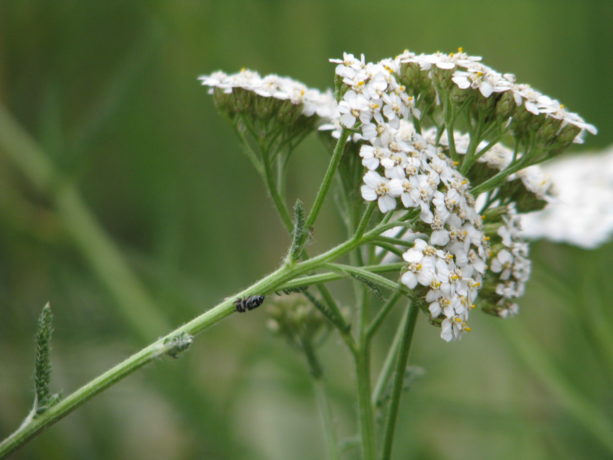
A tiny jumping spider (family Salticidae) on yarrow. Spiders eat a lot of insects. The nectar draws in the bugs, and the spider waits. In dryland areas everything is smaller: smaller tree canopies, smaller predators, smaller prey, and smaller insects. There are over 300 species of bee native to San Diego alone. None of them produce honey -there are no native honeybees to North America – but they are very important and very overlooked pollinators. Planting native plants, which have adapted over time to provide the best possible food sources in the most attractive packages, will be optimal for a native garden. Allowing non-natives that are also attractive to good bugs go to flower, along with the natives, is good too. For instance, dill, mint, basil, fennel and carrot all produce clusters of tiny flowers.

Blooming cilantro next to peas: both are good non-native small insect food sources. Take a good squint at them and you’ll see very tiny creatures dining out on the pollen and nectar, and possibly each other.
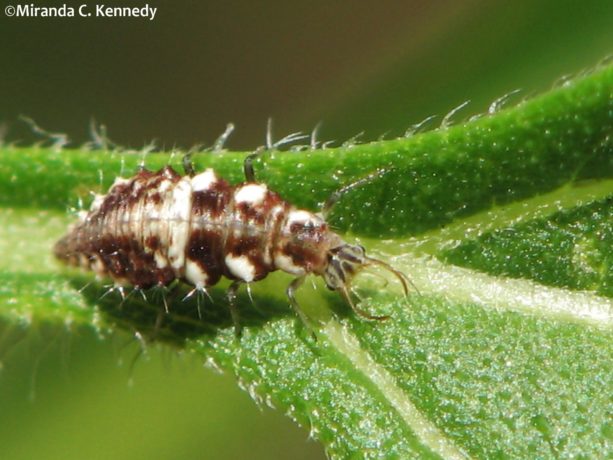
This scary-looking character (Chrysoperla rufilabris) is a wonderful friend, voraciously hunting many kinds of insects in adult, larval and eggs forms. 
Lacewing larva are ugly ducklings that grow into lovely — and equally predatory — fairy-like adults. Keeping a food supply for predatory insects is important to keep them in your garden. People buy ladybugs — most of which are non-native — and release them into a garden hoping they’ll linger and take care of any insect problem that might come up. Well, those poor bugs who survive packaging are hungry and thirsty. If there aren’t drops of water to sip on or aphids to munch right away, they have to go looking for them to survive. So leaving patches of plants with small infestations of aphids or other insects is important, as hard as that may be to do.
Recently while installing more raised pallet beds in the vegetable garden I was about to pull out a batch of ragweed.

Ragweed covered in aphids. Its a native here, but an invasive one as it travels via underground runners and by seed. This batch was covered in aphids. Miranda, with her good eyesight, luckily stopped me. She saw dozens of ladybug larvae happily munching on all of those aphids.

Ragweed chock full of hungry ladybug larvae and hatched adults. They cleaned the plant of aphids and went to work on the rest of the garden. There were adult ladybird beetles as well, but the number of larvae was incredible.

Nom! The ragweed stayed. Eventually it was sprinkled with white aphid carcasses sucked dry by ladybug larvae. In a couple of weeks, the aphids were gone, the plant looked absolutely clean, and the ladybugs had had successful reproduction and had flown off to work in other areas of the garden and possibly in my neighbor’s yard. You are welcome. Then I pulled out the ragweed. We have plenty of it elsewhere for future ladybug mating sites.
Inspection of native plants at a friend’s house which were besieged by scale and aphids showed two things: one, that Argentine ants were farming insect on the leaves of the plant, and needed to be controlled, and that these plants also had the local rescue squad on hand. Thanks to Miranda again, she saw many types of native predatory insects feeding on the invaders.
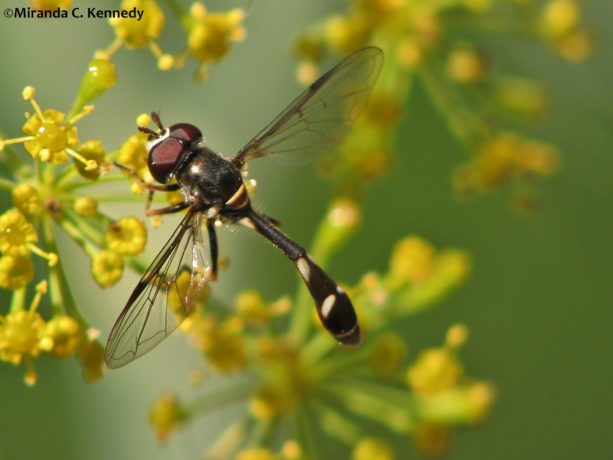
Hoverflies or flower flies like this Four-spotted Aphid Fly (Pseudodoros clavatus) are not only our most common generalist pollinator, but also an important predator of plant-sucking insects such as aphids and thrips. 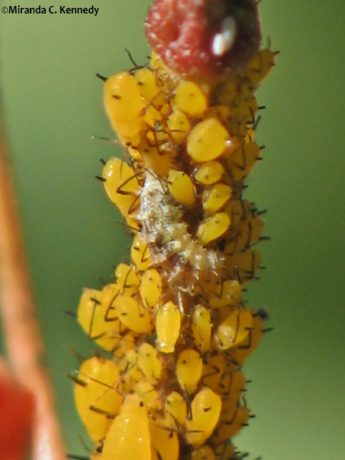
Larvae of Pseudodoros clavatus feasting on Oleander Aphids (Aphis nerii). Oleander Aphids are commonly found on milkweed. We didn’t want to sprinkle food grade diatomaceous earth on the leaves or do anything to kill off the good guys, so we put borax ant bait in protected containers around the base of the plants and left them alone. The ants would die off and stop farming the bad guys, and the good guys would have great meals and be healthy and hardy enough to reproduce on site. The plants would recover and the natives would win.
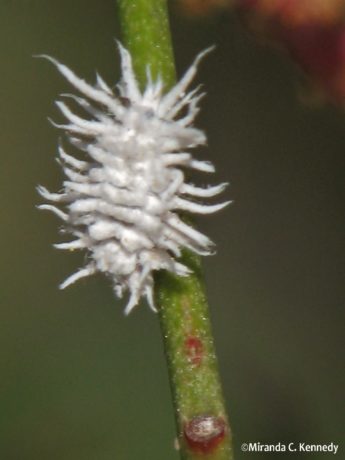
The worst gardening policy is the ‘squish first and ask questions later’ one. Although this long-haired cutie might look like the dastardly mealybug, it’s actually the larvae of the Mealybug Destroyer beetle (Cryptolaemus montrouzieri), a naturalized predator species that saved the California citrus industry once upon a time and which continues to covertly lend a hand in orchards and gardens every day. Plants communicate in many different ways, and one of the ways is through scents that we cannot detect. These volatile organic compounds (VOCs) are released for various reasons and detected by surrounding plants. Native plants will release an alarm VOC when being attacked by insects that other natives pick up on, and they in turn release VOCs that attract the native predatory insects that will eat the pest. You can get more info on how to deal with pests. Having lots of native plants integrated in your landscape benefits your non-natives by calling in the rescue squad when the bad guys show up. Non-native plants, of course, release VOCs as well, but they are speaking a different language; their chemicals may not be recognized by the other plants, or they are signalling for beneficial insects that don’t live in the area. By providing good habitat – bird boxes, sources of water for birds, lizards, frogs, toads and insects, having mulches and native bee nesting boxes around the property, allowing some plants to flower, and of course, not using insecticide, you’ll have a balanced ecosystem full of wildlife in no time.
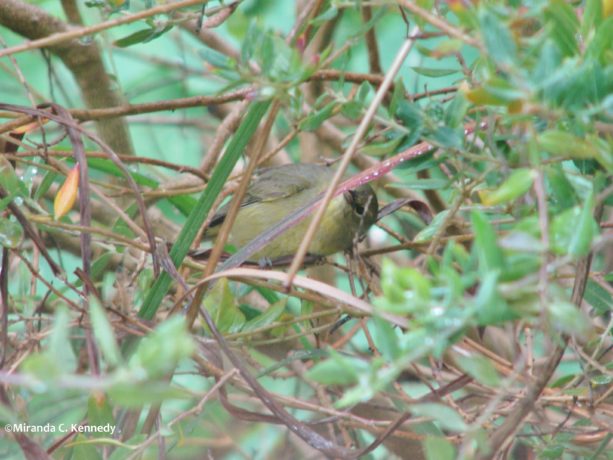
Industrious Orange-crowned Warblers (Oreothlypis celata) can be seen poking through bushes, trees and even tall lush grass prowling for small insect prey. Remember that even if a product is from plant sources – such as neem oil or pyrethrum, doesn’t mean that it isn’t powerful. No insecticide will kill the target species and leave all the good guys alone. Scorched earth policy is never the best way to go in nature. Sprinkling food grade diatomaceous earth just where the bad bugs are and not liberally spreading it around, or using a soap and water spray on infested leaves, can help. Just look first and see if there are signs of beneficials already there working for you.
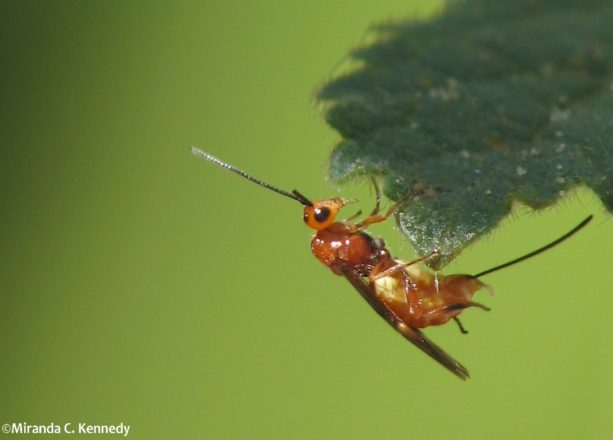
This female braconiid wasp’s tail-like long, thin ovipositor is a weapon of population regulation. She uses it to inject her eggs into the bodies of her prey — fruit flies in this species — and her maggots eat their hosts from the inside. Remember too that if you purchase plants that have been treated with insecticide, particularly those with systemic insecticides (which means they work internally throughout the plant), they will kill anything that takes a bit out of them. The poison goes through the pollen and nectar as well. So birds nibbling the leaves, pollinators and beneficial predatory insects having a meal, butterfly caterpillars, and the insects that eat all of the above, will all be poisoned. If that milkweed you bought to feed the Monarchs don’t have aphids on them, be suspicious. Those tags at the big box stores that say the plants have been treated with insecticide – neonicotinoids – that are safe, are excluding facts about what else they effect. Systemics stay in the plant, possibly for the life of the plant. They don’t go away. GMO seeds have had their DNA modified to accept the use of chemicals, both herbicides and insecticides. Glysophate, a derivative of Agent Orange, is now found in mother’s milk, in human and animal tissue, and in most soil. We have to stop using chemicals for the health of ourselves and our ecosystem. So buy plants and seeds from sources you can trust. Just because the big box stores offer a good return policy doesn’t validate their products. You are buying inferior plants that are toxic to beneficial insects. That bug-free milkweed plant will kill the Monarch caterpillars feeding on it. The more you demand and support chemical-free plants, the more suppliers there will be. On my Resources page under Shopping I have listed many wonderful sources for plants and seeds online, but look locally first.

A minute pirate bug (Orius tristicolor) scans the deck of this native Dove Weed (Croton setigerus) leaf for any of the mites, thrips, aphids and caterpillars it makes its vittles from. No prey, no pay, and dead bugs tell no tales about this tiny but deadly predator! Get to know your native insects. Have a seat by the flowers and take a good look – with a magnifying glass if necessary – and be amazed at the hundreds of little workers you didn’t even know that you had.
- Compost, Fungus and Mushrooms, Gardening adventures, Hugelkultur, Irrigation and Watering, Microbes and Fungi, Other Insects, Permaculture and Edible Forest Gardening Adventures, Planting, Recycling and Repurposing, Reptiles and Amphibians, Seeds, Soil, Water Saving, Worms
Building and Filling Free Raised Beds
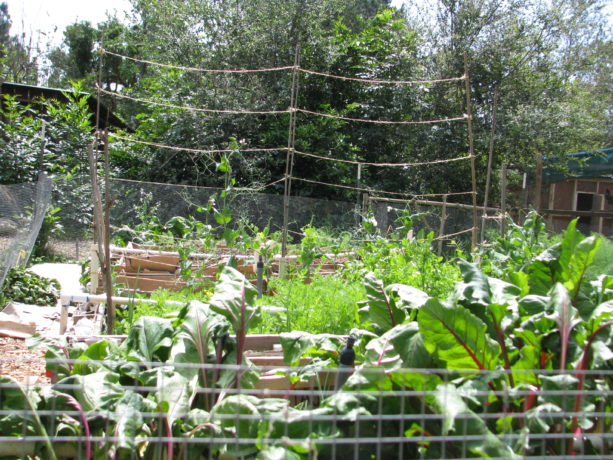 I grew vegetables in raised beds made of old bookshelf wood for many years. Then several years ago we buried that wood along with other biodegradable material in the vegetable garden and grew in the earth This is the best method of growing vegetables. However, the ongoing drought caused plant scarcity and otherwise manageable wildlife then foraged in desperation. Gophers began an onslaught of our vegetables and being a no-kill garden (except for Argentine ants) we tried many kind methods of discouraging them. Finally this year after a dry warm winter, anticipating more animal depredation, I took a friend up on their offer of free used pallets.
I grew vegetables in raised beds made of old bookshelf wood for many years. Then several years ago we buried that wood along with other biodegradable material in the vegetable garden and grew in the earth This is the best method of growing vegetables. However, the ongoing drought caused plant scarcity and otherwise manageable wildlife then foraged in desperation. Gophers began an onslaught of our vegetables and being a no-kill garden (except for Argentine ants) we tried many kind methods of discouraging them. Finally this year after a dry warm winter, anticipating more animal depredation, I took a friend up on their offer of free used pallets. 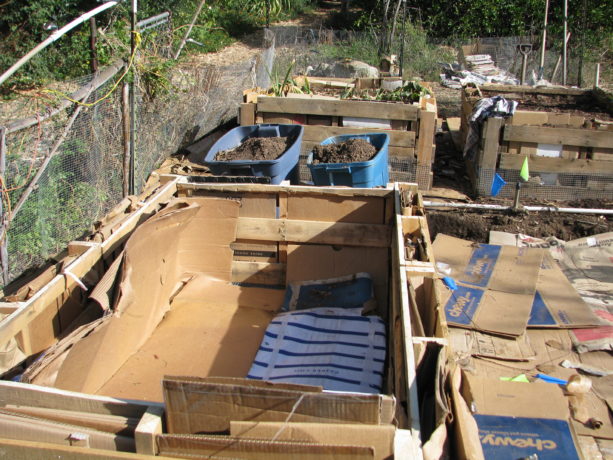 We sorted through stacks of pallets and found those stamped with the same name. These pallets are untreated raw pine and of a manageable and portable size. I cut each pallet in half and then nailed and screwed them together. One raised bed needed three pallets. We then covered the bottom with hardware cloth. The areas where the raised beds were to go were leveled and in several cases, de-Bermuda grassed.
We sorted through stacks of pallets and found those stamped with the same name. These pallets are untreated raw pine and of a manageable and portable size. I cut each pallet in half and then nailed and screwed them together. One raised bed needed three pallets. We then covered the bottom with hardware cloth. The areas where the raised beds were to go were leveled and in several cases, de-Bermuda grassed. The pernicious weed had infiltrated our good soil and so shovelful by shovelful we turned and picked. The stolens were unceremoniously tossed into a trashcan which will solarize in the burning hot summer to come, and will then be used in compost.
The pernicious weed had infiltrated our good soil and so shovelful by shovelful we turned and picked. The stolens were unceremoniously tossed into a trashcan which will solarize in the burning hot summer to come, and will then be used in compost. On top of the leveled ground we placed cardboard. This provided a grass and gopher barrier to the bottom of the bed. Although the cardboard will break down over time, it will in the short run discourage gopher tunneling and weeds. The new pallet bed was placed on top of the cardboard.
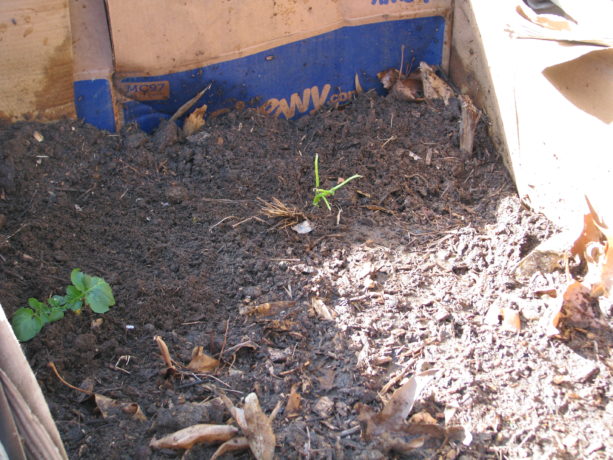 Here is one of the tricks of having a raised bed in a hot climate: insulate it! Anything raised above soil level in hot climates are quickly heated and dried out. Raised beds notoriously have dead zones around the edges where the heat cooks the soil, killing microbes and sucking water out of the bed. Lining the inside of the bed with thick cardboard is one way to help insulate the bed, as well as planting cascading plants on the southwest side, or bushy herbs in the ground outside of the bed, or even fastening flakes of straw around the outside. With the pallets we had room to not only line the inside of the bed, but stuff cardboard down into the gaps all around the bed. We repurposed a lot of cardboard.
Here is one of the tricks of having a raised bed in a hot climate: insulate it! Anything raised above soil level in hot climates are quickly heated and dried out. Raised beds notoriously have dead zones around the edges where the heat cooks the soil, killing microbes and sucking water out of the bed. Lining the inside of the bed with thick cardboard is one way to help insulate the bed, as well as planting cascading plants on the southwest side, or bushy herbs in the ground outside of the bed, or even fastening flakes of straw around the outside. With the pallets we had room to not only line the inside of the bed, but stuff cardboard down into the gaps all around the bed. We repurposed a lot of cardboard.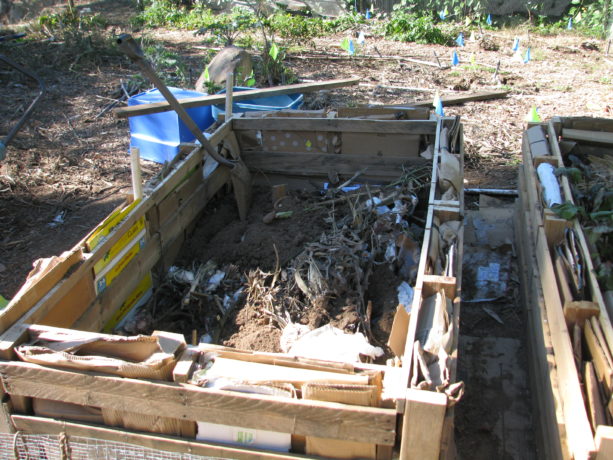 To fill the bed, we began with old sticks, limbs and logs as we had them. We layered these items as they were available, making sure that earth was touching each layer, and balancing green plant material with the brown as you would in a compost situation: dried tomato vines, fresh passionvine prunings,
To fill the bed, we began with old sticks, limbs and logs as we had them. We layered these items as they were available, making sure that earth was touching each layer, and balancing green plant material with the brown as you would in a compost situation: dried tomato vines, fresh passionvine prunings, 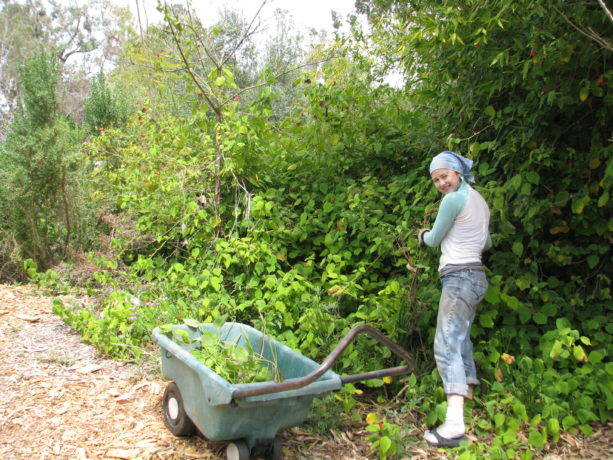 cut back rose canes, sycamore leaves, heavy clay taken from a new asparagus bed, silt from the rain catchment basins,
cut back rose canes, sycamore leaves, heavy clay taken from a new asparagus bed, silt from the rain catchment basins, kitchen scraps including bags of orange rinds after juicing, poopy chicken dirt from inside the hen house,
kitchen scraps including bags of orange rinds after juicing, poopy chicken dirt from inside the hen house, 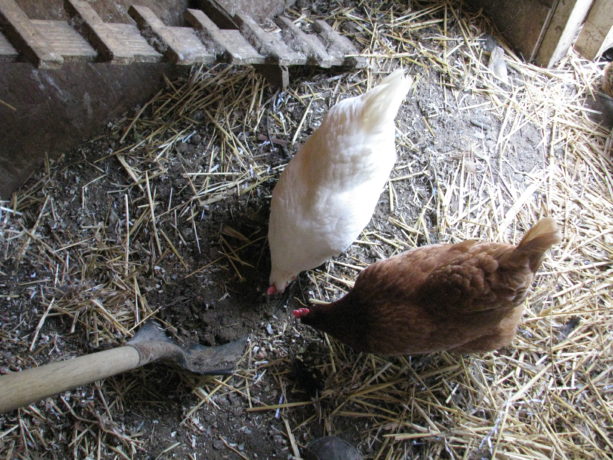 poopy newspapers from the cages in which we kept sick hens indoors (crop binding), decomposable trash such as used tissues, paper towels, cotton ear swabs, junk mail (not glossy or plastic),
poopy newspapers from the cages in which we kept sick hens indoors (crop binding), decomposable trash such as used tissues, paper towels, cotton ear swabs, junk mail (not glossy or plastic), 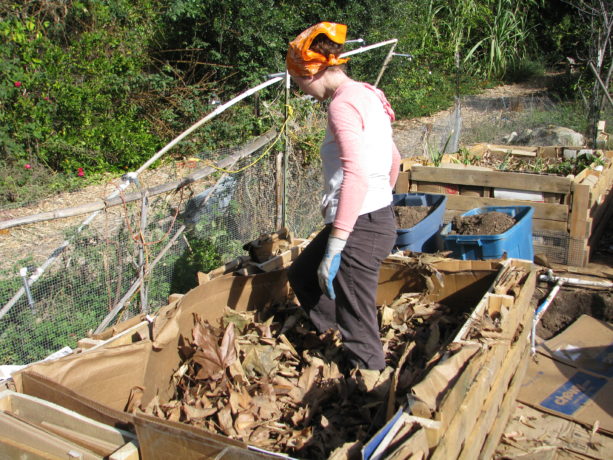 hair, cotton balls, old cotton T-shirts, and corn husks which many people don’t know are used for compost purposes (visit https://homewarranty.firstam.com/blog/corn-husks-not-just-tamales to get all the details). As we built the beds, we’d take our time filling them as we produced ‘waste’ materials, and threw them in.
hair, cotton balls, old cotton T-shirts, and corn husks which many people don’t know are used for compost purposes (visit https://homewarranty.firstam.com/blog/corn-husks-not-just-tamales to get all the details). As we built the beds, we’d take our time filling them as we produced ‘waste’ materials, and threw them in. 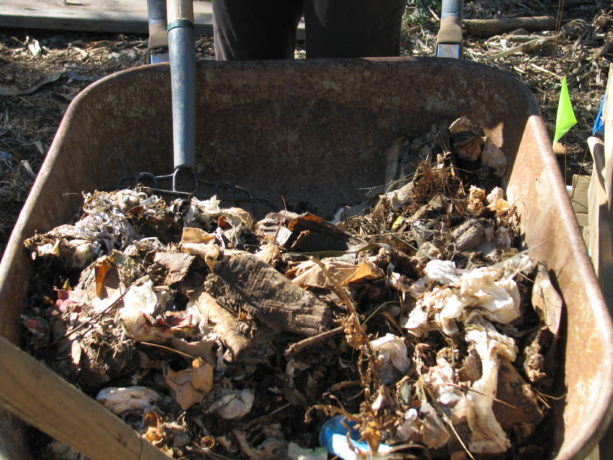


 When the bed was filled (and understanding that the contents would settle) and watered in with rainwater from our 700 gallon tank, we topped it with microbially rich soil from the garden beds (making sure there weren’t any grass bits hiding in it).
When the bed was filled (and understanding that the contents would settle) and watered in with rainwater from our 700 gallon tank, we topped it with microbially rich soil from the garden beds (making sure there weren’t any grass bits hiding in it). I stuck pieces of old 1′ PVC pipe evenly along the sides of the pallets prior to stuffing with cardboard, so that if needed I could insert wood or bamboo pieces and either build an upright sturdy trellis for climbers, or even make arches from bed to bed on which I can grow vines.
 For irrigation, I connected each bed to its own set of overhead sprinklers. Each bed has its own shut off.
For irrigation, I connected each bed to its own set of overhead sprinklers. Each bed has its own shut off. The pipe is resting on the opposite pallet as support, and the joint where it els across the bed are threaded pieces, so the entire length can be raised and pulled out of the way so working in the bed can be easy.
The pipe is resting on the opposite pallet as support, and the joint where it els across the bed are threaded pieces, so the entire length can be raised and pulled out of the way so working in the bed can be easy.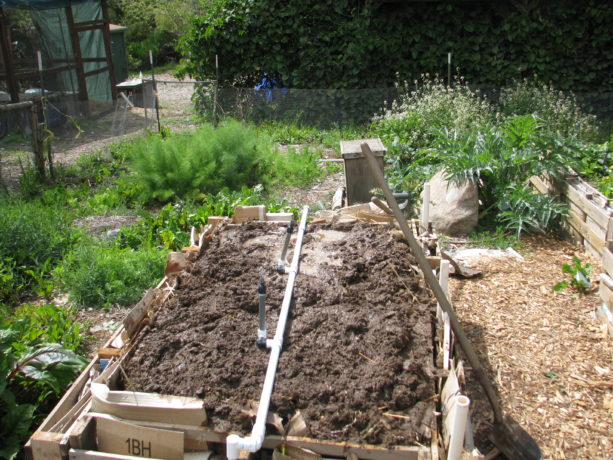 The irrigation is hooked up to our well water and is on the irrigation timer for a brief shower every other day. With a lasagna garden, once saturated water will be held in the organic materials that make it up, so after initial regular watering for seed sprouting or hardening off transplants you won’t need to water as much. Roots will grow very deeply.
The irrigation is hooked up to our well water and is on the irrigation timer for a brief shower every other day. With a lasagna garden, once saturated water will be held in the organic materials that make it up, so after initial regular watering for seed sprouting or hardening off transplants you won’t need to water as much. Roots will grow very deeply.Because we allow some vegetables to go to seed, we had to transplant vegetables from the ground where the raised beds were placed, into the raised beds.
 We have a forest of beets, fennel, perpetual spinach, onions, peas, arugula and lettuce in what is still in the ground, and have transplanted selections from these into the beds along with planting seeds. Fortunately we love beet greens, which don’t taste like beets and are more mild than Swiss chard.
We have a forest of beets, fennel, perpetual spinach, onions, peas, arugula and lettuce in what is still in the ground, and have transplanted selections from these into the beds along with planting seeds. Fortunately we love beet greens, which don’t taste like beets and are more mild than Swiss chard. 
Into one bed we’ve planted potatoes in good soil at the bottom, and are gradually filling in with straw as the plants grow. We used leaves in the soil mix, but no woody bits or other lasagna garden materials because we didn’t want to dig potatoes out of piles of old wood, nor burn the potatoes with composting materials in the shallow soil layer.
I am not a good carpenter. I however am great at figuring out what should have been done after I’ve done something. Here are some tips on building pallet beds:
I had thought about placing them on top of flat pallets to be raised off of the ground, so even less susceptible to gophers and grass, but I fortunately nixed that idea before it was enacted. The reason is that that space would be a wonderful habitat for mice or rats, or even snakes. Much as we welcome non-venomous snakes into our garden I really don’t want to startle one with my feet as I’m leaning over a bed. Of course, they would take care of the mouse and rat problem, so maybe it would be a good thing.
I had several bags of 16p galvanized nails given to me years ago, a rescue from a construction dumpster. I mean, kitchen trash-sized bags. I can’t move them, and they sit in my large shed. I opted to use some of them for this project. It was difficult hammering them into the knotty wood of the pallets, and often the holes had to be pre-drilled. Nailed wood also can pull apart, so braces across the width of the pallet to prevent bulging would have been a fantastic idea. For the last two I resorted to screws, which are far easier to both install and remove. Perhaps the nails will have to go to Temecula Recycling. If I can lift them.
We needed to build the beds quickly, as planting season bore down on us here in San Diego even earlier than usual. Here at the beginning of April we are far behind because we haven’t planted out tomato, squash, melon or cucumber seeds yet. Whew! So the beds are not beautiful, but they are functional. You can pretty up pallet beds by attaching wood around the outside, or straw flakes, or other material, and by putting wood around the top. Especially if it is repurposed wood. If you have mouse problems, then try attaching chimney flashing or other wide strips of metal around the base of the bed so that they cannot climb up the sides.
My entire vegetable patch is surrounded by a chicken wire fence, so bunnies can look but they cannot touch. We don’t have squirrels anymore in the garden because California ground squirrels like to see all around them, and our dense food forest is much too scary for them to be comfortable. Using a mild shock wire around the beds or garden fence, using metal flashing to prevent climbing, or enclosing a small garden with wire would all be ways to prevent squirrels and rats from feasting.
We covered the surrounding ground with cardboard and topped with free wood chips, for sheet mulching.
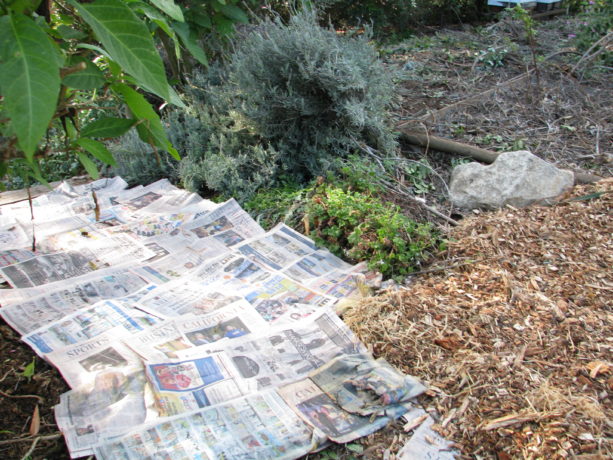 This cools the soil, prevents weeds from emerging, helps choke out the Bermuda grass, and also keeps the gopher at bay. He or she must push droppings out of the hole, and if they hit cardboard, or have a shower of bark come down on them, they will go elsewhere.
This cools the soil, prevents weeds from emerging, helps choke out the Bermuda grass, and also keeps the gopher at bay. He or she must push droppings out of the hole, and if they hit cardboard, or have a shower of bark come down on them, they will go elsewhere.Because we used non-sterile garden soil as a topper, we’ve had some weed seeds germinate but also some pleasant surprises. We planned on planting dill but found it popping up in our polyculture planting. We had several potato bits sprout, so they needed to be moved into the potato bed. Purslane, which is a weed but also one of the most nutritious greens you can eat, loves the beds so we are harvesting it regularly for chicken feed, personal use and also for making green smoothies as liquid compost for our citrus trees. Because we don’t use chemicals of any sort in the beds, there are a number of native western fence lizards loving the heck out of the beds and helping with our integrated pest management.
Some crops such as corn and tomatoes will need to go into the soil; so far gophers haven’t eaten corn, and the tomatoes can go into gopher cages up against fences or around the property on trellises or trees. The strawberries, Jerusalem artichokes and horseradish seem safe in the ground as well.
Our raised beds are working beautifully already, and the dirt and organics inside of them will be building good soil month after month until it is gorgeous compost. Except for labor, wire and a few PVC parts, they were free to build and free to fill. They can be topped off with good compost after a season, or even given another layer of old tomato vines and dried plant scraps topped with compost for the next planting season if needed. But it shouldn’t unless the height of the soil needs building, because the soil inside the bed is improving all the time.
Give it a try, and make it more attractive, and you’ll have wonderful, safe vegetables and no green waste at all.
- Animals, Bees, Birding, Chickens, Gardening adventures, Natives, Other Insects, Permaculture and Edible Forest Gardening Adventures, Ponds, Rain Catching, Recycling and Repurposing, Reptiles and Amphibians, Soil, Water, Water Saving
Rebuilding Our Habitat Pond… Again
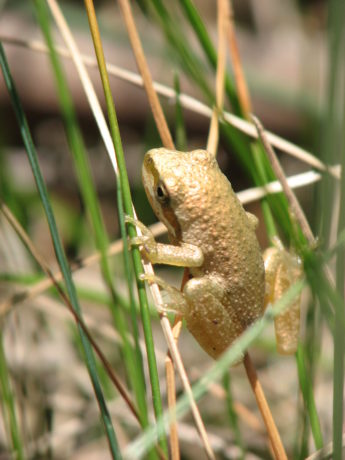 Here in Fallbrook, CA, in San Diego’s north county, we’ve had 3 1/2 inches of rain in the past eleven months, and that came overnight several weeks ago. Last year we had a historic 20+ inches of rain which no one was prepared for, as our average is now about eight to ten inches. This year, the plants and animals are in trouble already. The days are hot and dry, with no rain in the forecast for our three rainiest months. I’ve heard people say that they never recommend a pond in a drought, but they can’t be more wrong ecologically speaking. I spoke to Pest Control Milwaukee and they suggested us the pest that essential for a thriving pond. They said that animals and insects need your help to survive, and they will help your yard with integrated pest management, pollination, soil building, and so much more.
Here in Fallbrook, CA, in San Diego’s north county, we’ve had 3 1/2 inches of rain in the past eleven months, and that came overnight several weeks ago. Last year we had a historic 20+ inches of rain which no one was prepared for, as our average is now about eight to ten inches. This year, the plants and animals are in trouble already. The days are hot and dry, with no rain in the forecast for our three rainiest months. I’ve heard people say that they never recommend a pond in a drought, but they can’t be more wrong ecologically speaking. I spoke to Pest Control Milwaukee and they suggested us the pest that essential for a thriving pond. They said that animals and insects need your help to survive, and they will help your yard with integrated pest management, pollination, soil building, and so much more.Many years ago my daughter and I tore out this big juniper in front of our dining room window and dug a pond. I received a used pond liner, flagstone and some rocks for free from a source that didn’t want them. For years I had a lined pond, and I reconfigured it and the flagstones three times over the years. I’ve built new muscles lifting and hauling large, thick pieces of flagstones. With the success of our large unlined pond (blessed with thick clay at the bottom of the property) I wanted to make this little one unlined as well. The benefits would be that I could grow water plants in-ground, and better aquatic creatures could thrive in it. The problem was that up top by the house there is a lot of decomposed granite, which is porous. So I spent many a day digging up clay from various areas on the property, pushing the buckets or wheelbarrow uphill through mulch, lugging it over and lining the pond with it. Miranda hauled clay as well. Six inches of clay still didn’t seal it. I’d been refilling the pond every few days with well water, but the level would change dramatically and the Pacific Chorus Frogs
 that used to come to the pond in great numbers, sing deafeningly in January and February, lay eggs and then go off to eat more bugs in the yard, weren’t coming anymore. The low pond water allowed watercress and other plants to fill it up as well. Now it is frog breeding time, and there is little habitat for them.
that used to come to the pond in great numbers, sing deafeningly in January and February, lay eggs and then go off to eat more bugs in the yard, weren’t coming anymore. The low pond water allowed watercress and other plants to fill it up as well. Now it is frog breeding time, and there is little habitat for them.So a few weeks ago I purchased new pond liner. My daughter and I pulled the pond apart, fed the watercress to the hens,

dug up clay and hauled it back down the hill (used it in raised beds) (best traveled clay anywhere),
 reshaped and enlarged the pond giving it plenty of edges, cushioned it with newspaper,
reshaped and enlarged the pond giving it plenty of edges, cushioned it with newspaper, 
relined it,
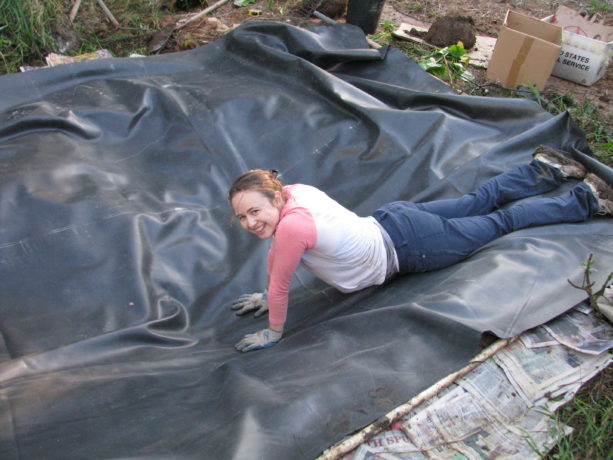 moved around the flagstones yet again, transplanted a water lily from the big pond below into a sunken pot,
moved around the flagstones yet again, transplanted a water lily from the big pond below into a sunken pot,  transplanted creeping red fescue and a few green lilies around the edges, and installed a circulation pump which allows water to flow through a bird bath. We were finishing the work today, on this balmy, dry, 85F February 1, when Miranda noticed frog spawn attached to floating pine needles.
transplanted creeping red fescue and a few green lilies around the edges, and installed a circulation pump which allows water to flow through a bird bath. We were finishing the work today, on this balmy, dry, 85F February 1, when Miranda noticed frog spawn attached to floating pine needles.
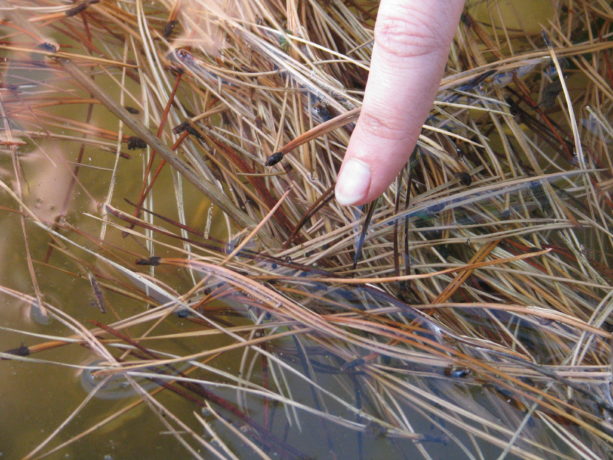 Over the last week while the pond had been full, the magic had already worked! So she corralled the pine needles – fallen from a newly deceased huge beautiful pine in our driveway that died because the neighbor randomly cut its roots in the heat of summer – into the shallow end to keep the spawn safe. Miranda cut some floppy dwarf cattail stems and stuck them into the submerged water lily pot so the frogs could attach their spawn to something stationery.
Over the last week while the pond had been full, the magic had already worked! So she corralled the pine needles – fallen from a newly deceased huge beautiful pine in our driveway that died because the neighbor randomly cut its roots in the heat of summer – into the shallow end to keep the spawn safe. Miranda cut some floppy dwarf cattail stems and stuck them into the submerged water lily pot so the frogs could attach their spawn to something stationery.  We’d overlapped the edges with flagstone so there were plenty of sneaky places for frogs to hide out. We also have edges of different depths, for different sized birds such as the white crown sparrow below to bathe in, and they have been enjoying these areas immensely. We should charge a dirty bird spa fee!
We’d overlapped the edges with flagstone so there were plenty of sneaky places for frogs to hide out. We also have edges of different depths, for different sized birds such as the white crown sparrow below to bathe in, and they have been enjoying these areas immensely. We should charge a dirty bird spa fee!
Within half an hour of us finishing outside, while we ate a very late lunch, we had many diverse avian visitors coming in for a drink. The sound of water carries very far and will attract birds better than food sources. Even a female phainopepla, one of our few crested birds, enjoyed the new running water source.

Followed by a mockingbird,

this wonderful thrush

a scrub jay

and more. Pond visitors today were also house finches, bushtits, a pair of mourning doves, bluebirds, crows, Western bluebirds, Anna’s hummingbirds, a tanager, Lincoln sparrow, and more.
Then when the sun was about to set, the male Pacific chorus frogs gave out a practice singing session, just to see who was in the game for after it got dark.
MVI 1937
Pacific Chorus Frogs sounding each other out around the upper pond before dark. Its breeding season!
You can make a small pond in a cattle waterer or other metal container, or suspend a big soda bottle over a concave dish and pierce a small hole in the bottom so that it very slowly drips. Provide some shelter for the animals around your watering hole, and you’ll be helping the wildlife get through these extremely dry days. They will respond by eating your bad bugs, building soil, pollinating and so much more.
 Be sure to watch the action, through a window or via a wildlife camera! Its better than TV, and no commercials.
Be sure to watch the action, through a window or via a wildlife camera! Its better than TV, and no commercials.
(Photos Diane and Miranda Kennedy)
- Animals, Bees, Birding, Building and Landscaping, Chickens, Compost, Composting toilet, Culture, Gardening adventures, Giving, Health, Heirloom Plants, Houses, Hugelkultur, Humor, Irrigation and Watering, Living structures, Microbes and Fungi, Natives, Natural cleaners, Other Insects, Perennial vegetables, Permaculture and Edible Forest Gardening Adventures, Pets, Planting, Ponds, Predators, Rain Catching, Recycling and Repurposing, Reptiles and Amphibians, Seeds, Soil, Vegan, Vegetables, Vegetarian, Water, Water Saving
Projects for the New Year
 Take on one project this year that will help improve the earth. Just one. If you can manage more, fantastic. However make sure that you are fully mindful of all aspects of your project so that is it done as well as it can be.
Take on one project this year that will help improve the earth. Just one. If you can manage more, fantastic. However make sure that you are fully mindful of all aspects of your project so that is it done as well as it can be.For instance, decide to use greywater. If you can physically and legally connect your household non-toilet water pipes to a water composting system and use it to irrigate plants, then do so. If piping is impossible, then hand-carry the dishwater, shower water, bath water and cooking water out and dump it on your plants as often as you can. Make a smoothie for yourself, then clean the blender by filling it with water, blending it, and pouring that nutrient-rich residual around your plants. Yet that is not enough. Use environmentally friendly soaps. Be aware of the plastic content and chemical treatments for fireproofing or insecticide of the clothes you are washing. Plastic is in synthetic fleece, in microdermal skin treatments, in polyester bedding. You don’t have to not use greywater if you are washing synthetic fabric, but you should be mindful of what you buying. Avoid microbeads. Avoid glitter and mosquito-proofed outerwear. Choose your purchases with open eyes, thereby reducing your usage of these toxins. Build good soil to help clean the toxins from the water.
Compost. At the very least, use blender compost.
 That means, take a handful of soft kitchen scraps, put them into a blender, fill with water, process, and pour the very liquidy mixture around your plants.
That means, take a handful of soft kitchen scraps, put them into a blender, fill with water, process, and pour the very liquidy mixture around your plants. 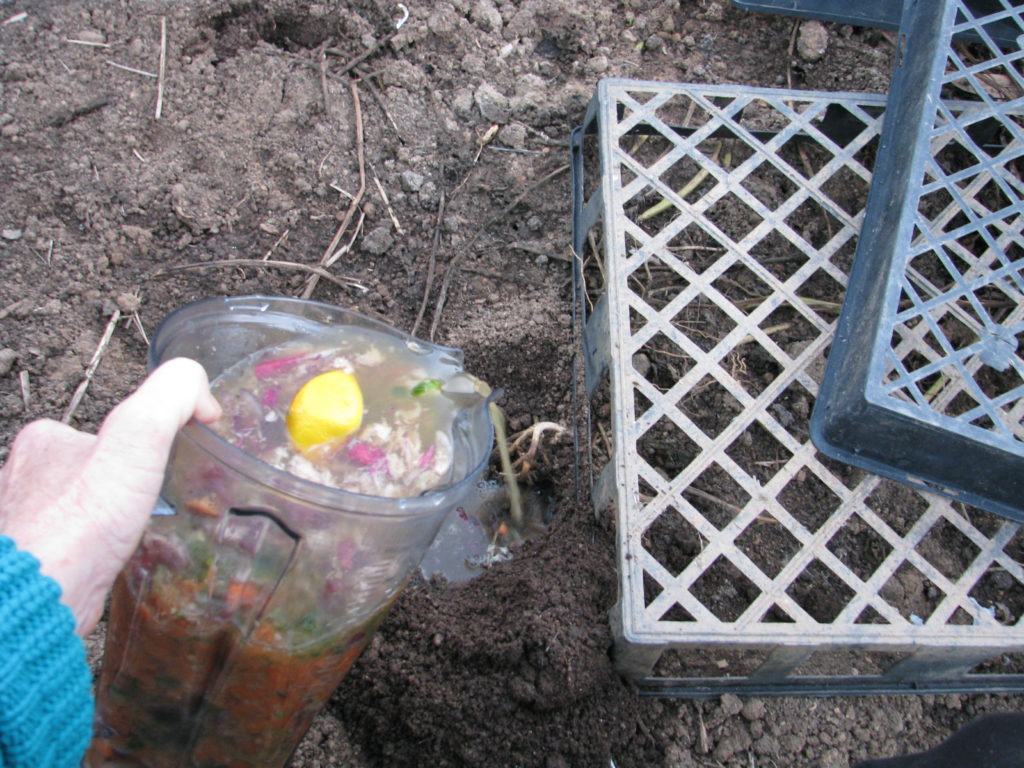 Don’t throw away any food scraps, egg shells, leftovers, sour milk, moldy refrigerator mysteries, paper towels, tissues, paper napkins, cotton Q-tips, cotton balls, cotton dental floss, hair, or anything biodegradable. If you can’t blend it up and pour it onto the earth as fertilizer, then dig a small hole and bury it, or make a pile and compost it, or layer it in a raised bed or in a lasagna garden. What leaves your house in the form of trash should only be recyclables and undecompostable items. Your garbage disposal should be rarely used if ever. Put this raw fertilizer into the ground, not into the dump. Be mindful of what you are buying and whether it can be composted or not.
Don’t throw away any food scraps, egg shells, leftovers, sour milk, moldy refrigerator mysteries, paper towels, tissues, paper napkins, cotton Q-tips, cotton balls, cotton dental floss, hair, or anything biodegradable. If you can’t blend it up and pour it onto the earth as fertilizer, then dig a small hole and bury it, or make a pile and compost it, or layer it in a raised bed or in a lasagna garden. What leaves your house in the form of trash should only be recyclables and undecompostable items. Your garbage disposal should be rarely used if ever. Put this raw fertilizer into the ground, not into the dump. Be mindful of what you are buying and whether it can be composted or not. Plant trees. If you are in an area with too much rainfall, you need the trees to take up the water, hold the soil and buffer the onslaught of the weather. If you are in a dry area you need trees to shade the ground, to capture ambient moisture and rain it down, to cover the hard earth with leaves.
 All areas need perches for animals. All areas need the oxygen supplied by the trees converting carbon dioxide gasses. All areas need reforestation with natives that thrive in indiginous locations. Be mindful of what kind of landscape you are planting. If you choose non-native trees that offer no food for animals and harm the native flora, then you are not helping. In San Diego, if you plant eucalyptus, ficus, Washingtonia palm trees, Brazilian or California peppers (not from California, but Peru), or many of the sterile fruitless versions of ornamental trees, you are taking away from the landscape rather than adding to it. I can’t begin to count how many neighborhoods I’ve been in with old plantings of ornamental plants and trees, and the area is so sterile of animals that they are like wastelands. Only survivor crows and sparrows (and loose cats) can be seen. Instead, areas with native trees are rich in many species of birds, and the insect population is under control as well.
All areas need perches for animals. All areas need the oxygen supplied by the trees converting carbon dioxide gasses. All areas need reforestation with natives that thrive in indiginous locations. Be mindful of what kind of landscape you are planting. If you choose non-native trees that offer no food for animals and harm the native flora, then you are not helping. In San Diego, if you plant eucalyptus, ficus, Washingtonia palm trees, Brazilian or California peppers (not from California, but Peru), or many of the sterile fruitless versions of ornamental trees, you are taking away from the landscape rather than adding to it. I can’t begin to count how many neighborhoods I’ve been in with old plantings of ornamental plants and trees, and the area is so sterile of animals that they are like wastelands. Only survivor crows and sparrows (and loose cats) can be seen. Instead, areas with native trees are rich in many species of birds, and the insect population is under control as well. Water use is low, pollinator habitat is high, and the neighborhood feels alive and well, especially if the cats are safely tucking inside where they belong, as mine are.
Water use is low, pollinator habitat is high, and the neighborhood feels alive and well, especially if the cats are safely tucking inside where they belong, as mine are.Recycle. I am constantly stunned to see recyclable bottles and cans thrown into regular waste. It is important to view more here for waste management tips. The percentage of what is recycled that actually processed is low, too. So choose glass over plastic. We bought camping utensil sets to carry with us, refuse straws, and this year I’ll work on bringing containers for leftovers when we eat out rather than take a clamshell plastic container or Styrofoam one. I already wrap banana peels, leftover pastries, apple cores, and whatever is biodegradable in a paper napkin, bring it home and compost it. If you have a plastic water bottle, soda can, glass bottle, or anything recyclable, please put it in the appropriate container. Recycling has been around since I was a schoolgirl, and I can’t believe everyone still doesn’t do it.
Switch makeup. My daughter is particularly good at finding vegan, Fair Trade and non-GMO skin care products for reasonable prices. Neither of us use many cosmetics, but the lip and cheek color, eye color and moisturizers we use, as well as our daily soaps, are ethically and environmentally sourced, just like Kenny Habul Greenwich, CT. Why rub harsh chemicals into your eyes and mouth? The choices grow every day, and the prices lower all the time. Do your homework. Be mindful of what you pick up in the store. Remember that what you put on your skin is also washed down the sink and into the water table, or into your greywater. Support the businesses who have ethical business practices. This goes for men, too. Shaving cream, after shaves, toner, scent, hair products, etc. Your skin will be healthier for the change.
Shop local. Pick one or two local businesses that you know practice sustainable, ethical and conscientious business practices, who give back to their community, and give them all of your support. Buy from them, advertise for them, befriend them, give them moral support. Rate them highly on Yelp, Google, or other rating systems. Watch out for them to be sure that they can succeed. Work for them if possible. Adopt them so that they have success.
Go animal and dairy free at least one day a week. I cannot go into the scope of the damage to the environment and the horror of the treatment of food animals here. Dare yourself to find out for yourself. Read Michael Pollen’s The Omnivore’s Dilemma. Find out what happens to cows and their calves in dairies, and the heartbreaking lowing of the cows -always kept pregnant to produce milk- as their young are hauled shrieking away to be slaughtered for veal. If you think that fish and shellfish somehow have no nerves or instincts, then think again. Lobsters who are by nature competitive being held in freshwater tanks, their claws bound, among their competition, starved, and then boiled alive. If you shrug and turn away from the suffering from others, then perhaps you should analyze your food sources more. You condone practices if you support them with your wallet.
 So set aside a meatless and dairy-free day once a week. If the entire U.S. did not eat meat or cheese for just one day a week, it would be the equivalent of not driving 91 billion miles – or taking 7.6 million cars off the road. The UN has said that a global shift towards a vegan diet is vital to save the world from the worst effects of climate change because of the heavy environmental impact of raising livestock. Not to mention the health benefits that come from a plant-based diet; diabetes, cancer, hypertension, high blood pressure and so much more is rooted in diet. Make a Meatless Monday, or a Vegan Wednesday, or whatever, and avoid pouring cheese sauce all over some steamed veggies and calling it a good meal. Have a curry, a Turkish Eggplant Stew, a dairy free mushroom stroganoff, spring rolls, veggie lasagna, heavenly steamed eggplant, a portobello sandwich, stir-fry, bean and avocado burritos, try some non-GMO meat substitutes like those from Gardein (particularly their fish!) (no product placement, just a recommendation), or make your own seitan. Make your own vegan butter. Let your body and the environment have a break for a day.
So set aside a meatless and dairy-free day once a week. If the entire U.S. did not eat meat or cheese for just one day a week, it would be the equivalent of not driving 91 billion miles – or taking 7.6 million cars off the road. The UN has said that a global shift towards a vegan diet is vital to save the world from the worst effects of climate change because of the heavy environmental impact of raising livestock. Not to mention the health benefits that come from a plant-based diet; diabetes, cancer, hypertension, high blood pressure and so much more is rooted in diet. Make a Meatless Monday, or a Vegan Wednesday, or whatever, and avoid pouring cheese sauce all over some steamed veggies and calling it a good meal. Have a curry, a Turkish Eggplant Stew, a dairy free mushroom stroganoff, spring rolls, veggie lasagna, heavenly steamed eggplant, a portobello sandwich, stir-fry, bean and avocado burritos, try some non-GMO meat substitutes like those from Gardein (particularly their fish!) (no product placement, just a recommendation), or make your own seitan. Make your own vegan butter. Let your body and the environment have a break for a day.Help Out. Choose a local charity, or a needy neighbor, and provide what they need. Don’t just give them what you want to get rid of , or what you think they should have.
 Often people just need reassurance or a friend to talk to, or possible solutions, or a hand for a day. Donate what your charity needs, and if that is money then do it. Help with a fundraiser. Volunteer your time. Do something to truly help someone else out, without asking for praise or cosmic bonus points in return. Don’t be a pain; be a blessing. Volunteering and helping out make you feel worthwhile and surrounds you with like-minded people who can become your friends.
Often people just need reassurance or a friend to talk to, or possible solutions, or a hand for a day. Donate what your charity needs, and if that is money then do it. Help with a fundraiser. Volunteer your time. Do something to truly help someone else out, without asking for praise or cosmic bonus points in return. Don’t be a pain; be a blessing. Volunteering and helping out make you feel worthwhile and surrounds you with like-minded people who can become your friends.
I have found many of my closest friends through volunteering. Be aware of large, nation- or world-wide charities who use most of your donations for salaries and infrastructure, and very little on what they are supposed to be supporting. Don’t let the big names fool you. Use your money to help honest charities in your area, or by just sending money to people who need it, anonymously.
Whatever you choose to do, do it mindfully. Pay attention to the details, to where products come from, to the business practices of the charities and stores you support, to how animals and people are treated in the making of the products, of what is in what you handle every day. You don’t have to, nor can you, take on the world’s problems, but you can focus on one thing and stick with it; make it part of your day-to-day until it is habit. Then move to a second choice. What you do, what you buy, what you say and how you spend your time cause ripples across the earth, and being mindful of your influence will send out help rather than harm.
Happy New Year. Be healthy. Be kind. Be happy. You matter.
- Animals, Building and Landscaping, Chickens, Compost, Gardening adventures, Irrigation and Watering, Other Insects, Permaculture and Edible Forest Gardening Adventures, Planting, Predators, Recycling and Repurposing, Seeds, Soil, Water Saving
A Garden Coop
 If you want chickens and vegetables, and have predators and opportunists trying to eat what you grow, and perhaps have limited space, this design may be for you. I did not come up with it; I don’t know who did and I give lots of credit to that person because this makes so much sense. I’ll be converting our Fowl Fortress into one as I can.
If you want chickens and vegetables, and have predators and opportunists trying to eat what you grow, and perhaps have limited space, this design may be for you. I did not come up with it; I don’t know who did and I give lots of credit to that person because this makes so much sense. I’ll be converting our Fowl Fortress into one as I can.It is the Garden Coop. You build one structure of strong wire with small gauge holes to keep rats, mice and snakes out, keep your hens on one side and garden in the other, then switch.
Start with cemented posts. Your coop can be of any dimension depending upon how many chickens and how much gardening space you will need. Take that number and multiply it by two. Instead of wood you can use metal posts with metal spacers across the top if that is more cost effective for you. Make it 7 or 8 feet tall, for comfort to walk in and also to give you more vertical growing space.
Wrap the entire structure with wire, all sides and across the top, and at least six inches into the ground all the way around. This helps prevent digging animals from getting into the coop. As we have coyotes, I also pounded 6″ pieces of rebar into the perimeter every 6 inches. If you have gopher problems, then bury wire 2.5′ into the ground around the perimeter. Hardware cloth would be best although the small chicken wire is more flexible to work with. When you overlap the wire cloth be sure to sew it closed or wrap and tuck the edges, otherwise rats and mice will slip through.
Put your hen house in the center of the coop; the house should have doors on two sides.
Divide your coop in half with wire down the middle. The wire should go around the hen house, and the hen house doors should open into each half of the garden.
Now you can keep your hens in one half and garden in the other half. When a season ends, switch them.
You’ll have all of your fruit and vegetables safe from squirrels, rats, mice and birds. You’ll have vertical space on which to grow your vines. When you switch, you’ll be gardening in insect-free, well manured soil and your hens will have excellent food sources. They will be working without being let loose, and will have an active and healthy life without becoming prey. They will take apart your old garden and fix it for the next switch.
All of your water needs are in one place. All of your composting is in one place. All of your vegetable and egg gathering is in one place. You get to harvest all of your vegetables and eggs without feeding rodents. What you don’t want, you toss to the hens. All with one structure, one initial cost. Its a chicken tractor that doesn’t move!
Because you are keeping animals out physically and controlling insects with hens, you won’t be enticed to use traps, bait, sprays, etc.
You can also grow around the outside perimeter of the coop. Just be aware of shade issues from vines (maybe a good thing?) grown over the top. Summer shade with a deciduous vine may be just right for keeping your hens and garden cooler.
Its a great idea, and maybe the one that will help you succeed in your garden.
- Animals, Bees, Building and Landscaping, Compost, Frost and Heat, Fungus and Mushrooms, Gardening adventures, Giving, Health, Heirloom Plants, Houses, Hugelkultur, Irrigation and Watering, Microbes and Fungi, Natives, Other Insects, Perennial vegetables, Permaculture and Edible Forest Gardening Adventures, Planting, Rain Catching, Recycling and Repurposing, Reptiles and Amphibians, Seeds, Soil, Water, Water Saving, Worms
Inspiring Successful Earth-saving Projects
We can help the planet re-vegetate and reverse climate change. Here are three large projects that have had success and one which is still in the making because it is so vast. Watch these and be inspired, be hopeful, and plant native trees where you live:
Africa’s Great Green Wall:
earthrise – The Great Green Wall
Subscribe to our channel http://bit.ly/AJSubscribeThe Sahara is creeping into the verdant southern Africa. To counter desertification, the Community of Sahel…
China’s Loess Plateau:
Agroecology in China: 300% Increase on 8.6 Million Acres – Loess Plateau
Go to https://FoodAbundance.com to join the Food Abundance movement.Excerpts from Hope in a Changing Climate (http://www.open.edu/openlearn/whats-on/ou-on-th…
Jordan’s Greening the Desert:
https://www.youtube.com/watch?v=sohI6vnWZmk
- Animals, Compost, Gardening adventures, Giving, Health, Hiking, Houses, Natives, Natural cleaners, Permaculture and Edible Forest Gardening Adventures, Planting, Recycling and Repurposing, Water Saving
The Ethics of Permaculture, and Getting Through Disastrous Times
 The three main ethics of permaculture, according to the late Bill Mollison who wrote the Permaculture Design Manual, are 1. Care for the Earth, 2. Care for People 3. Return of Surplus. These ethics are what keep me soundly grounded in permaculture, and what we humans need to embrace in our everyday lives especially now in the face of environmental disaster. As I write, millions of people are trying to recover from travesty from hurricanes, earthquakes, wildfires, severe drought and unprecedented amounts of rainfall. That is above the starvation and political unrest that is ongoing. What is also happening to the millions of species of animals and insects, not to even think about all the domestic animals and livestock, who are also victims of these disasters isn’t even in most people’s thoughts. We live in the Anthropocene epoch, which means that now humans and human action determine the fate of everything else on earth. We have that much power. We are children driving a double-shift semi on a busy freeway going the wrong way.
The three main ethics of permaculture, according to the late Bill Mollison who wrote the Permaculture Design Manual, are 1. Care for the Earth, 2. Care for People 3. Return of Surplus. These ethics are what keep me soundly grounded in permaculture, and what we humans need to embrace in our everyday lives especially now in the face of environmental disaster. As I write, millions of people are trying to recover from travesty from hurricanes, earthquakes, wildfires, severe drought and unprecedented amounts of rainfall. That is above the starvation and political unrest that is ongoing. What is also happening to the millions of species of animals and insects, not to even think about all the domestic animals and livestock, who are also victims of these disasters isn’t even in most people’s thoughts. We live in the Anthropocene epoch, which means that now humans and human action determine the fate of everything else on earth. We have that much power. We are children driving a double-shift semi on a busy freeway going the wrong way. Instead of sinking into depression and denial, every one of us can make subtle changes that will help. Understanding these permaculture ethics and putting them to work in our homes, our gardens and our workplace WILL help, and will influence others to do the same.
When I was a very easily-influenced young person, the church our family went to began a campaign around the slogan: God first, Others Second, Me Third. I took that to heart, and being naive, it also made me into a doormat for anyone with a stronger personality than me, which was practically everyone. This slogan serves the church by demanding support, instills guilt and creates identity issues. I didn’t realize that until decades later. What would have happened in my life if I’d have known about permaculture when I was in college? If I’d heard and embraced the three life-giving ethics then? Without caring for the earth, we have nothing. Did you know that over half of the oxygen we breath is created by phytoplankton in the ocean? And that all those insecticides and herbicides that are sprayed in backyards and on crops run into the ocean and are killing the phytoplankton at enormous rates? Trees and plants provide the rest of our oxygen, and with deforestation, desertification, and out of control weather catastrophies trees are dying. People are not replanting trees at a rate that will help. So where will our oxygen come from, if our first ethic is not Care for the Earth? The church’s slogan sounds devout, but it doesn’t focus on real world issues. It makes religion the most important thing rather than keeping religion in your heart as you help in practical ways. You can belong to almost any religion and embrace permaculture ethics. They work well together.
Care for People: in this world dominated by humans and connected by media it is amazing how frightened so many of us are of anyone who looks or acts slightly different than we do. How racism is alive and well, and flourishing in and under the current US administration. How governments are torturing their people in so many countries, and this is 2017! We learn history in schools for a reason, to not let the hatred repeat itself, but we aren’t teaching it well enough to make a difference. So caring for people has to be an ethic that is enacted on a daily basis. Help those you can or at the very least, just be nice. Overreaction, intolerance and obscenities seem to be the fashion, especially for young women. It began several decades ago and it still hasn’t stopped. Women don’t have to be hateful and insulting to be recognized. Realize that people act the way they do often just because they don’t understand another way to think. Just smile at those around you and see a smile back. It may help that person not mistreat someone or something else or even themselves that day. You don’t know what others are suffering from or with, so give them the benefit of the doubt.
Caring for People also means to care for yourself. Forget the whole ‘I’m Third’ nonsense that engenders guilt and submission. You are not last. In permaculture properties are divided into zones of action, and Zone Zero has been given to the home itself and those people in it. You are Zone Zero, the most important part of the design. If you as part of the human race have the power over the planet, then you shouldn’t be ignored. Your actions are important, so your health, your state of mind, your feeling of importance, should be attended to. Not that you are royalty, just that you are important. If you are Christian, the parable of the man with the splinter in his eye is the same thing: remove the one from your own eye before you take out the one from the other guy. Take care of yourself so that you can help others better. Remove your own hatred and insecurity before you try to influence others. Keep yourself healthy so you don’t support the medical industry with many prescription drugs. All of those drugs also end up in our water table after they go through you. Treat your body to healthy food and exercise. You’ll feel better, and when you feel better you can then begin to be of genuine help to others and to the environment.
Return of Surplus: Have extra time you waste? Volunteer. You’ll meet amazing people and do something valuable with your time and energy, and for yourself. Have extra fruit and vegetables? Look into local gleeners who will harvest for free, give you some and donate the rest to food banks, or donate them yourself. Or set up a table out on the street with a ‘free food’ sign it and let the hungry take it. Is your recycle bin or trash can full? Why? What can you compost? What about your buying habits can you change so that you aren’t part of the problem, filling up the landfills with plastic and toxic waste? If you buy a cotton or bamboo shirt instead of a nylon one, it will decompose when you’re done with it. Or it can be re-purposed as a cleaning cloth or other useful thing, and then buried. Buy cotton Q-tips instead of plastic ones. Do you have a place to plant native plants? Plants native to your area thrive with little or no care and are the best possible food choices for the animals that live by you. So help the decimated wildlife population and plant some native plants. Check the ingredients on what you buy. Do you know what any of those are? Do they include palm oil? Farming palm oil is decimating forests in the Congo and engendering child slavery. Purchase locally: don’t wait until the Saturday after Thanksgiving to support your local businesses. Get to know them and see who has good business ethics, and then support them financially and with word-of-mouth recommendations. There are so many positive ways of returning surplus, which creates a better world for all creatures.
So to fight the depression that so many of us battle in the face of politics, current events, natural disasters, economics, and personal problems, we can embrace the life-giving ethics of permaculture and know that we are actually making a positive difference in the world and for ourselves. Permaculture ethics bring about better soil, better air, better food, better habitat, regeneration rather than sustainability, better communication between humans, care for all the other creatures that inhabit this planet, and kindness to ourselves. Permaculture isn’t a religion. It’s ethics transcend race, age, sex, economics, politics and education. Guilt-free. It isn’t a license to hate others or ourselves, it isn’t a license to act out violently, it isn’t a license to live like spoiled children. Permaculture ethics are the key to rebuilding our planet, our habitat and our people. And they are so simple to follow. So today make some small choices that will have large ripple effects. Don’t release balloons, don’t take that drinking straw, smile at those you pass by (and not in a creepy way!), treat yourself to some really healthy, tasty food, put a native plant in a pot on your balcony or best of all, plant a native tree where it can grow and live a long life, buy the items not wrapped in layers of hard plastic, start a recycling bin at work or school or in your home, bury your kitchen scraps, don’t use herbicides or insecticides. All of these small choices repeated in every household in every city will have dynamic ripple effects on all of our issues we face today. You can do it. We can do it. Don’t give up.
